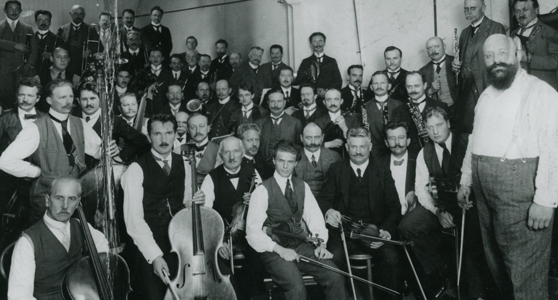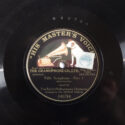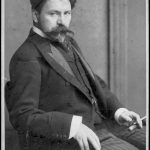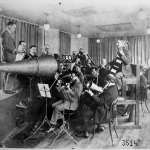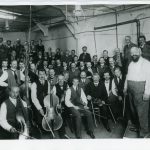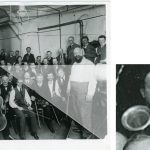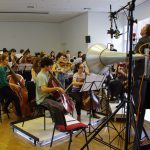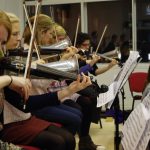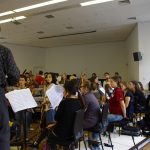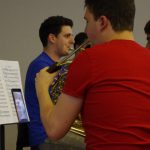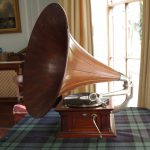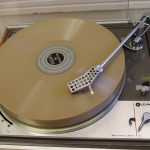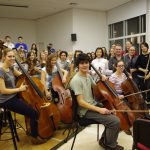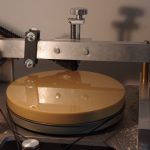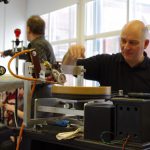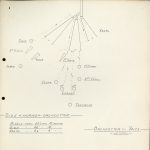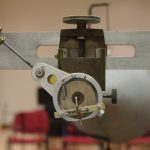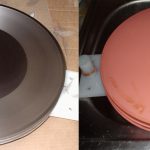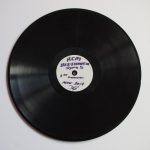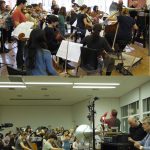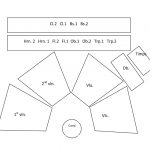The Art and Science of Acoustic Recording: Re-enacting Arthur Nikisch and the Berlin Philharmonic Orchestra’s landmark 1913 recording of Beethoven’s Fifth Symphony
Abstract
https://dx.doi.org/10.15180/150302/001The Art and Science of Acoustic Recording was a collaborative project between the Royal College of Music and the Science Museum that saw an historic orchestral recording from 1913 re-enacted by musicians, researchers and sound engineers at the Royal College of Music (RCM) in 2014. The original recording was an early attempt to capture the sound of a large orchestra without re-scoring or substituting instruments and represents a step towards phonographic realism. Using replicated recording technology, media and techniques of the period, the re-enactment recorded two movements of Beethoven’s Fifth Symphony on to wax discs – the first orchestral acoustic recordings made since 1925. The aims were primarily to investigate the processes and practices of acoustic sound recording, developed largely through tacit knowledge, and to derive insights into the musicians’ experience of recording acoustically. Furthermore, the project sought to discover what the acoustic recordings of the past do – and don’t – communicate to listeners today. Archival sources, historic apparatus and early photographic evidence served as groundwork for the re-enactment and guided its methodology, while the construction of replicas, wax manufacture and sound engineering were carried out by an expert in the field of acoustic recording. The wax recordings were digitised and some processed to produce disc copies playable on gramophone, thus replicating the entire course of recording, processing, duplication and reproduction. It is suggested that the project has contributed to a deeper understanding of early recordings and has provided a basis for further reconstructions of historical recording sessions.
Keywords
acoustic recording, re-enactment, Royal College of Music, tacit knowledge, wax discs
Introduction
https://dx.doi.org/10.15180/150302/002The 1913 recording of Arthur Nikisch and the Berlin Philharmonic Orchestra’s interpretation of Beethoven’s C minor Symphony (No. 5) holds a special place in the history of recorded music. Not because it was the first complete recording of a symphony, as that had already been achieved some three years earlier, but because it was the first recording of a complete orchestral work by a world-renowned conductor, now considered to be one of the greatest conductors of all time, together with a leading professional orchestra.[1] What is arguably of equal significance is that it was one of the very first attempts to capture the natural sound of a full orchestra in the studio, and without the substitution of harder-to-record instruments as was commonplace throughout the ‘acoustic’ period.[2] The recordings are highly successful in this respect, and testimony to the skills of the studio engineers or ‘experts’ who were working at the very limits of what was feasible using the technology of the period. In acoustic sound recording, musicians play in front of a large tapered horn that channels the sound energy and causes a diaphragm, enclosed in a soundbox or recorder connected to the narrow end of the horn, to vibrate. These vibrations in turn modulate an attached cutting stylus, allowing it to etch an undulating spiral groove on to the surface of a warm wax disc or cylinder, corresponding to the diaphragm vibrations and thus recording the sound information in physical form. Given the challenges of recording in this way, it is not surprising that this version of Beethoven’s Fifth Symphony remains one of few recordings of the early acoustic era that employed such large orchestral forces and without substitution of the lower stringed instruments. In fact the practice of using pared-down ensembles with substituted instrumentation to represent orchestral music would continue until the mid-1920s when there was a wholesale change-over to electrical methods of sound recording.
Although highly lauded during their time and even decades later,[3] acoustic recordings of orchestral music have been routinely dismissed by modern critics as having little or no musical value – as being a poor indication of how an orchestra from this era would have sounded in the concert hall or through being unfairly compared to later, electronically recorded versions.[4] The limitations of acoustic recording – the lack of low and high frequency bandwidth, narrow dynamic range, missing timbral detail and the accompanying surface noises – are today perceived as a barrier to the appreciation of these records. Yet historically they represent a transformation in the way we have come to listen to recorded music as well as being extraordinary achievements in the technical field of sound engineering.[5] By understanding how these recordings were made – the contemporary studio practices and musicians’ working environment – we can better appreciate the musicianship and artistry that went into their making. A practical re-enactment of an acoustic recording session would therefore yield valuable information and help promote such an understanding, with both technical and musical aspects and their interrelation being closely observed and documented. To this end, a re-enactment of the Nikisch and BPO’s recording of Beethoven’s Fifth Symphony was staged at the Royal College of Music, London, in November 2014, using a chamber orchestra of comparable size to that used by the BPO in 1913.[6]
The historical re-enactment is an important means through which we can engage with the past and investigate forgotten practices and skills. In this case, to borrow from Roger Kneebone’s advocacy of scientific re-enactment, it is used ‘to recapture the tacit dimensions of experimental practices’ (Kneebone and Woods, 2014, p 111). The ‘learning by doing’ aspect of a re-enactment has educational value too: the student musicians participating in the recordings at the RCM not only step into their predecessors’ shoes, but they are also educated in the practice, process and context of acoustic recording (Kneebone and Woods, 2014, p 111).
While re-enactments of acoustic recordings have taken place before, they have focused exclusively on small groups or soloists with accompaniment and have been recorded on to wax cylinders or occasionally on to modern, commercially manufactured lacquer discs.[7] The RCM re-enactment is the first time since 1925 that an orchestra has been recorded acoustically on to blank wax discs, originally used as masters for the production of gramophone records.
This article begins with an examination of the historical context and cultural significance of the original 1913 recordings. It goes on to describe the process and methodology of this re-enactment, including a detailed account of the technical aspects and the manufacture of the blank wax discs. A comparison of modern and acoustic recordings of the orchestra follows, including a discussion of the student musicians’ experiences, the challenges involved and the effect this method of sound recording had on the performers and their music-making. In conclusion, we reflect on the outcomes of the re-enactment and how our findings have deepened our understanding of the art and science of acoustic recording.
Section 1
https://dx.doi.org/10.15180/150302/003Historical context: orchestral records – a step towards phonographic realism
Arthur Nikisch and the BPO’s recording of Beethoven’s Fifth Symphony was published in Germany by the Deutsche Grammophon AG in February 1914 as a set of four, doubled-sided, twelve-inch discs.[8] The Gramophone Company released it in Britain as a series of eight singled-sided twelve-inch discs, each movement on two discs being issued separately over a period of eight months, from January until August 1914, beginning with the Andante movement.[9] The complete set of discs sold for a total of £2 in Britain at a time when ‘the average weekly wage was £1 6s. 8d. (or £1.33)’ (Day, 2000, p 7). These expensive editions were aimed at wealthy and discerning record collectors in order to satisfy a growing demand for orchestral recordings of classical music that were not truncated versions or arrangements for military band (Arnold, 1997, pp 15–19). Such a collector would also have owned a superior quality gramophone, capable of reproducing a twelve-inch orchestral record without distortion.[10] The records were reissued in Britain as four double-sided twelve-inch discs in 1922.
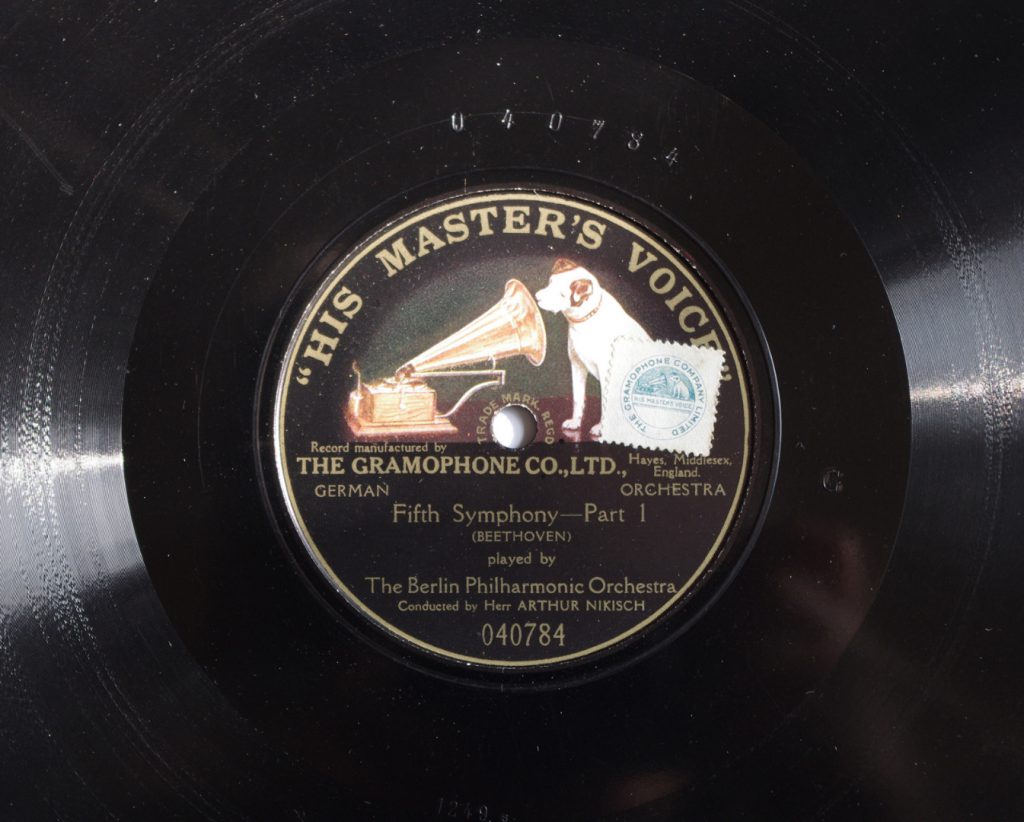
The greatest selling-point of these records was not the complete Beethoven symphony in C minor, but the ‘combination of artists equal to any in the world under a conductor of such world-wide reputation’.[11] This was indeed a significant event in the history of recorded music: ‘as the first conductor of high eminence to work before the recording horn, Nikisch bequeathed a distinguished endorsement of the phonograph as a medium for symphonic music’ (Gelatt, 1977, p 183). By 1913, Nikisch already had an illustrious international career as a conductor, but his sole contribution to the record catalogues had been as piano accompanist to the mezzo-soprano Elena Gerhardt, making recordings of German Lieder in 1907 and 1911. On 18 June 1913, he signed an exclusive five-year contract with the Gramophone Company, with an agreement to conduct three recording sessions per annum.[12] After the much-publicised Beethoven’s Fifth and a clutch of overture recordings with the London Symphony Orchestra the following year in June 1914, Nikisch’s recording career with the Gramophone Company was dramatically cut short by the outbreak of the First World War.[13]
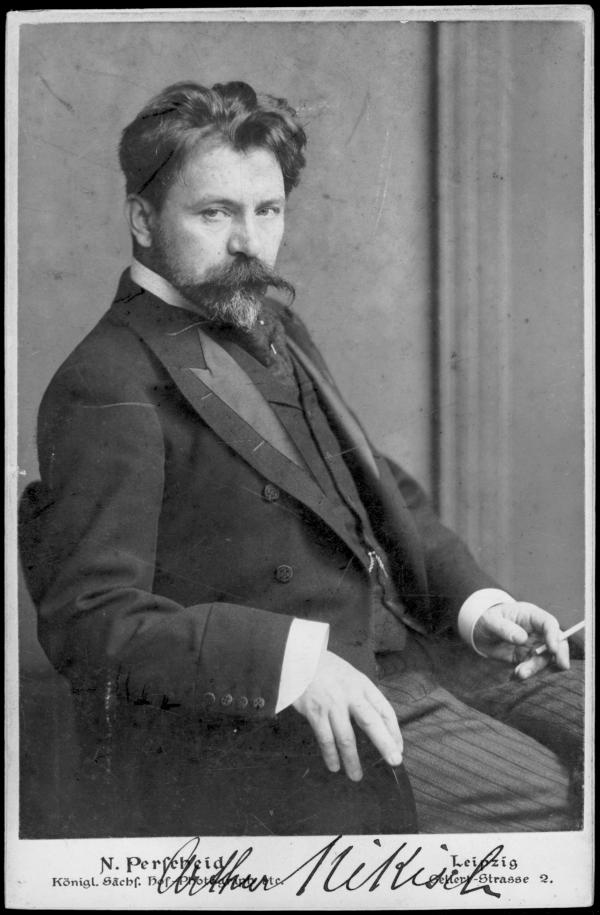
The Gramophone Company had sought to engage Nikisch to conduct an orchestral recording in 1911. A letter from Leo B Cohn, director of Deutsche Grammophon to his British colleagues, in which he discusses a proposed recording with Nikisch and Gerhardt, also reveals the Gramophone Company’s plans for a far more ambitious project:
You will understand that Nikisch has a very great name all over the world, especially in Germany, and I am sure, that it will help the sale of the records, if we can say that Nikisch has [plaid] the accompaniment. If you tell Nikisch what you want, I am sure that he will play the piano just the way we want it. I do not think, you will make any records with orchestral accompaniment because, Miss Gerhardt is singing ‘Lieder’ without exception.
It is a splendid idea, which I have considered long ago frequently, if we could make records of a large Symphony Orchestra with Nikisch as conductor. It is a big scheme and a great talking point. I think you can get Nikisch very cheap and anyhow, it is worth our while to find out, what Nikisch wants.[14]
The letter shows the high regard in which Nikisch was held. The bonus of getting the great conductor ‘very cheap’ may well have been a deciding factor and one should not overlook the importance of financial concerns in the decision making and choices of repertoire and recording artists for what was, essentially, a large corporation with commercial interests. What is more telling, however, is the remark that if instructed, Nikisch ‘will play the piano just the way we want it’. This would suggest the importance of a musician’s complicity in the process of acoustic recording; a studio ‘expert’ would dictate the manner in which musicians should play or sing, in order that they make a recording that is suitable for reproduction on a gramophone, never mind their artistic status. This had nothing to do with the musical taste or judgement of the studio bosses, but was a matter of necessity.
In order to achieve a proper balance on the recording (in this case, of voice and piano) and to maintain a constant audible level throughout, the playing style might have to be radically altered – for example, the piano is played louder, perhaps in a more precisely articulated or exaggerated way than when playing in a concert recital. The singer would also have to obey technical directions, directing her voice into the mouth of the horn, turning slightly or stepping back during loud passages so as not to overload the sensitive recording diaphragm and so ruin the recording.[15]
An orchestra in the acoustic studio presented an additional set of problems. It was not possible simply to point a horn at a large group of musicians and expect them all to be registered on the recording; their positioning required very careful planning.[16] Quieter instruments had to be placed close to the horn mouth, the louder ones further away or to the side; some had to be substituted because of lack of space in front of the horn mouth. This was especially true of stringed instruments, their open sound being difficult to capture by the acoustic process. Cellos were substituted or reinforced by a bassoon or bass clarinet, double basses by a tuba or contrabassoon.[17]
A solution for recording the upper strings was found in the mechanically amplified ‘Stroh’ violins and violas – a radical re-design of the violin by Augustus Stroh using the sound reproducing technology of the phonograph.[18] Characterised by its large aluminium horn, the Stroh violin is a highly directional instrument and could simply be pointed towards the recording horn. The first and second violins and violas would be reinforced or substituted entirely by two Stroh violins and a Stroh viola. This became standard practice by 1905 and continued until the end of the acoustic era in 1925.[19]
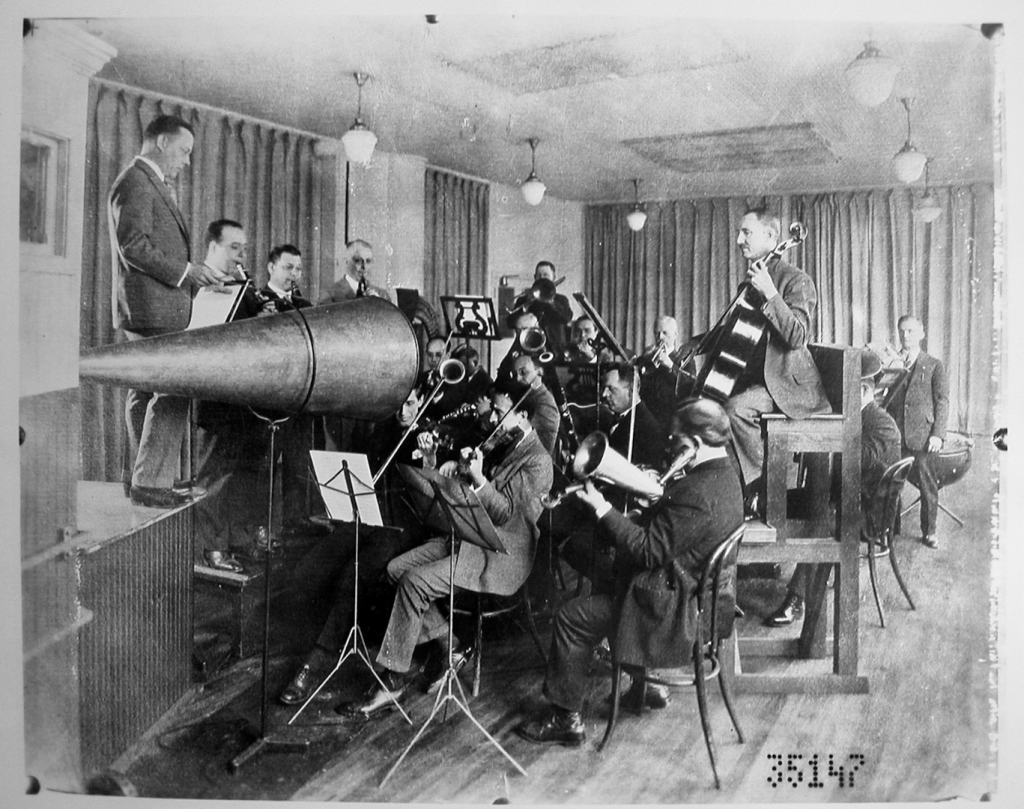
In this re-modelling of music for the gramophone, the orchestral rendition becomes an artifice. Recordings of the acoustic era are an impression, rather than a phonographic representation. But the recordings made by the Berlin Philharmonic Orchestra in 1913, I will argue, represent a step towards greater realism in sound recording and reproduction. Recorded music, formerly seen as a novelty without serious artistic value, was gaining critical acceptance and as recording and reproduction techniques improved, with them came the desire to hear faithful representations of the classical repertoire, as interpreted by great artists of the era.
Arthur Nikisch’s first orchestral recording was of Beethoven’s Egmont Overture, with the London Symphony Orchestra on 28 June 1913, at the Gramophone Company headquarters in Hayes. It is a standard orchestral recording of the period in which one clearly hears a tuba substituting the basses in the loud passages and the orchestra is audibly reduced. The Stroh violins are very prominent, resulting in the lack of a coherent ensemble string sound. This session may well have been a warming-up exercise, to initiate Nikisch into the trials of recording an orchestra in the studio, ahead of the ambitious Beethoven’s Fifth recording that was to take place five months later. In September 1913, in Berlin, an equally ambitious recording project took place in the same studio space where Nikisch would later record the Beethoven symphony.[20] The BPO, conducted by Alfred Hertz, recorded excerpts from Wagner’s Parsifal on eight sides that were published as twelve-inch records.[21] The exercise took four days to complete, from 12–16 September, with a day’s break in-between, possibly allowing for a test pressing to be made.[22] In contrast, for the Fifth Symphony Nikisch would record the entire symphony with the same orchestra, also on eight sides, in just one day on 10 November 1913.
The extra investment in time, studio resources and, presumably, musicians’ fees on the extended Parsifal sessions would suggest that much effort and experimentation took place in the Berlin studio until satisfactory results were achieved. While these recordings of a large Wagnerian orchestra are an outstanding achievement in their own right, they may well have served as a testing ground in preparation for the session with Nikisch in November 1913. The feat of recording an entire symphony with Nikisch at the helm would have been a far greater prize in terms of prospective record sales and prestige.[23] The recording expert for both the September and November sessions was Max Hampe, who had gained considerable experience of acoustic recording as an assistant to recording pioneer William Sinkler Darby.[24]
Aside from listening to the recordings there is some additional evidence confirming that neither the September nor November BPO recordings were re-orchestrated (i.e. the musical score adapted and instruments substituted). Firstly, a German record brochure advertisement for Beethoven’s Fifth Symphony lists the full instrumentation as specified by the composer, and is therefore promoting it as an authentic orchestral recording.[25] Secondly, there is a portrait photograph from September 1913 of Alfred Hertz and the BPO in the studio, taken at the recording of Parsifal.[26] The picture shows a fifty-two-piece orchestra, unusually large for the studios of the time, with approximately sixteen violins and violas, at least two cellos and three double basses.[27] The customary Stroh instruments are out of view, hidden in the back row of the string sections, a lone horn from a Stroh violin betraying their use and evidence that they would have reinforced the conventional violins and violas rather than dominate them. The orchestra for the recording of the Fifth Symphony would have been a smaller size than for Parsifal, but there is no reason to doubt the advertised authentic instrumentation. Max Hampe and his studio assistants had managed to capture the sounds of both a Wagnerian and a classical orchestra, without re-orchestration and for commercial release, perhaps for the first time in recording history.
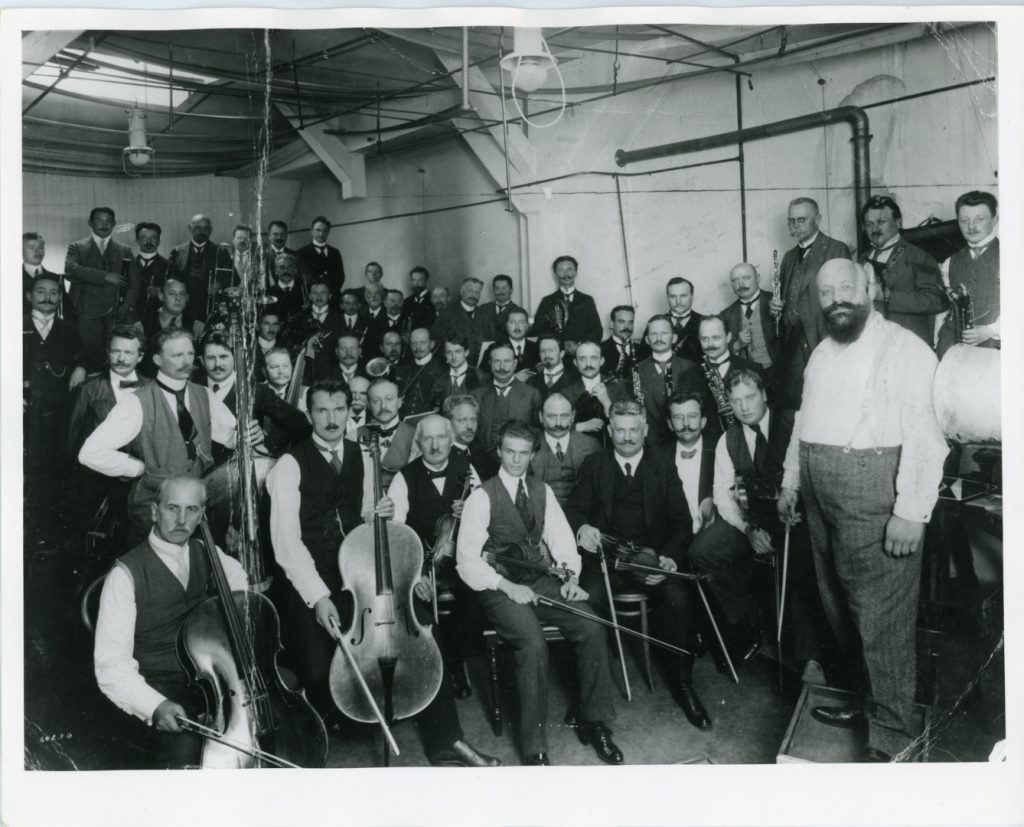
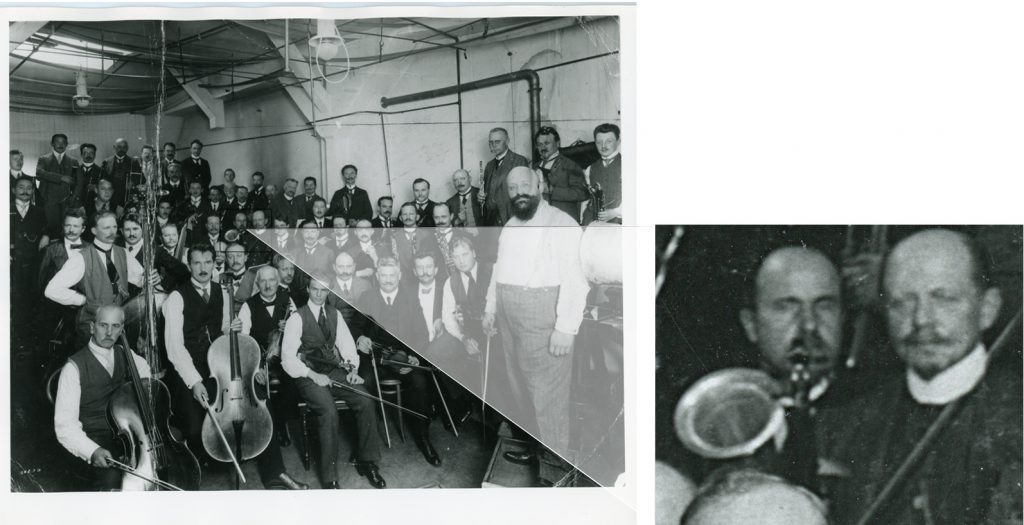
Historical basis for the staging of the recording re-enactment
The techniques of recording smaller ensembles and soloists have been fairly well documented in studio documents of the period.[28] However, very little is known of how a large orchestra might have been recorded acoustically.
We are left to rely on contemporary photographic evidence to guide us in arranging the musicians in front of the recording horns.[29] While some photographs show the musicians facing towards the camera rather than the recording horn, their positions remain basically the same as during recording, although players at the front might be placed far closer to the mouth of the horn for the recording than pictured. A common arrangement was to place the stringed instruments (and soloists) at the front, facing towards the horn mouth; woodwinds playing across the face of the horn, while the brass is situated at the very back. Timpani, if used, are placed outside the sector of the horn to prevent overloading the soundbox diaphragm during loud passages. In most cases, the brass and woodwinds would be seated on specially constructed platforms as this would enable the sound of each instrument to have a clear trajectory towards the mouth of the recording horn. Space was at a premium and musicians were packed very closely together to stay within the horn’s recording range. Music stands gave way to sheet music suspended by string from the ceiling using clothes pegs and some studios installed special rigging on the ceiling for this purpose. The conductor would stand elevated to the side of the recording horn; the room, even for an orchestral session, would be of a small size so as to contain the sound and reflect it back into the mouth of the horn. Because the musicians had to play louder than in a concert hall and very much closer together, the sound in these studios would have been intense.[30]
Positioning of the orchestra for the re-enactment
With no other existing sources of information about the November 1913 session available, the photograph of Alfred Hertz and the BPO served as a starting point for the RCM recording re-enactment. Although they are posing for the camera, the general positions of the musicians seem correct for recording, except that the string players would be further forward, the first row being right in front of the recording horn (its mouth appears just to the right of the picture). Hertz is shown standing on a small platform in front of the horn, but this space would certainly have been occupied by the violins and the conductor’s real position is out of shot, towards the narrow end of the horn. For the re-enactment at the RCM, the same arrangement was followed except that the cellos and double basses were moved close to the front of the horn, the instruments facing just underneath the horn mouth.

Two Stroh violins and a Stroh viola were used along with their conventional counterparts, as specified in studio memoranda.[31] They were initially positioned at the very back of the string sections on a riser, as suggested by the Stroh horn in the 1913 photograph of the BPO, but because of the general faintness of the violins and violas on our test recordings, they were moved forward, taking a central position in among the other string players and closer to the mouth of the horn. The improvement in the overall balance of orchestral forces and the added presence of the violins and violas on the recordings was especially noticeable in the quieter passages of the Andante movement. The stage of the RCM’s Recital Hall was used for the brass and timpani; the two French horn players had to be seated backwards so their bells faced towards the recording horn, and a mirror was installed so that they could watch the conductor’s movements, as was standard practice in the acoustic recording studios.[32]

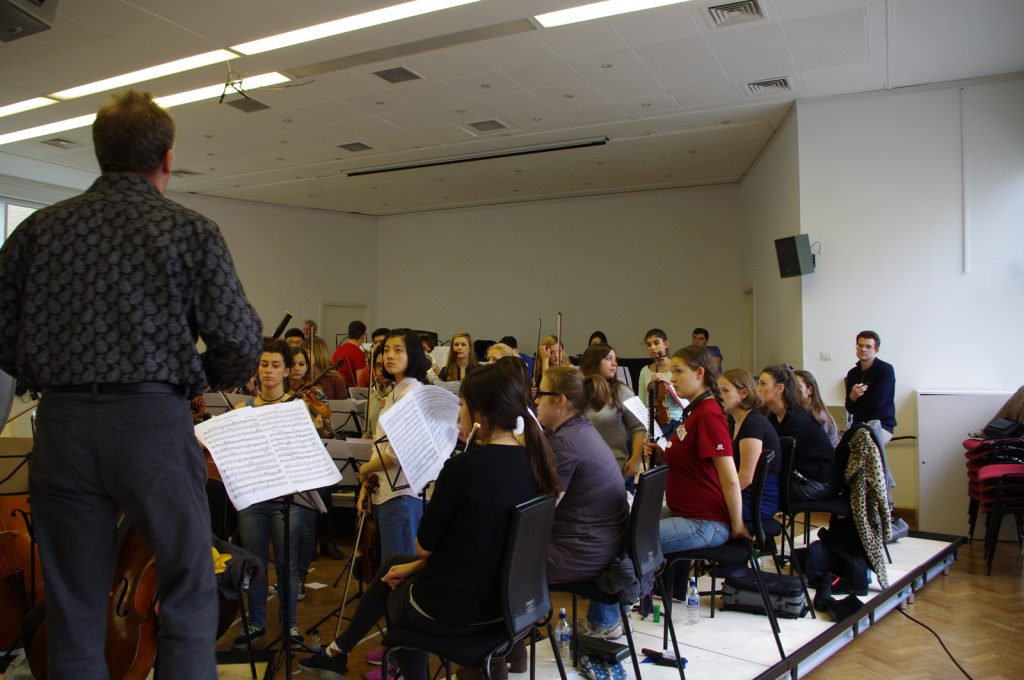
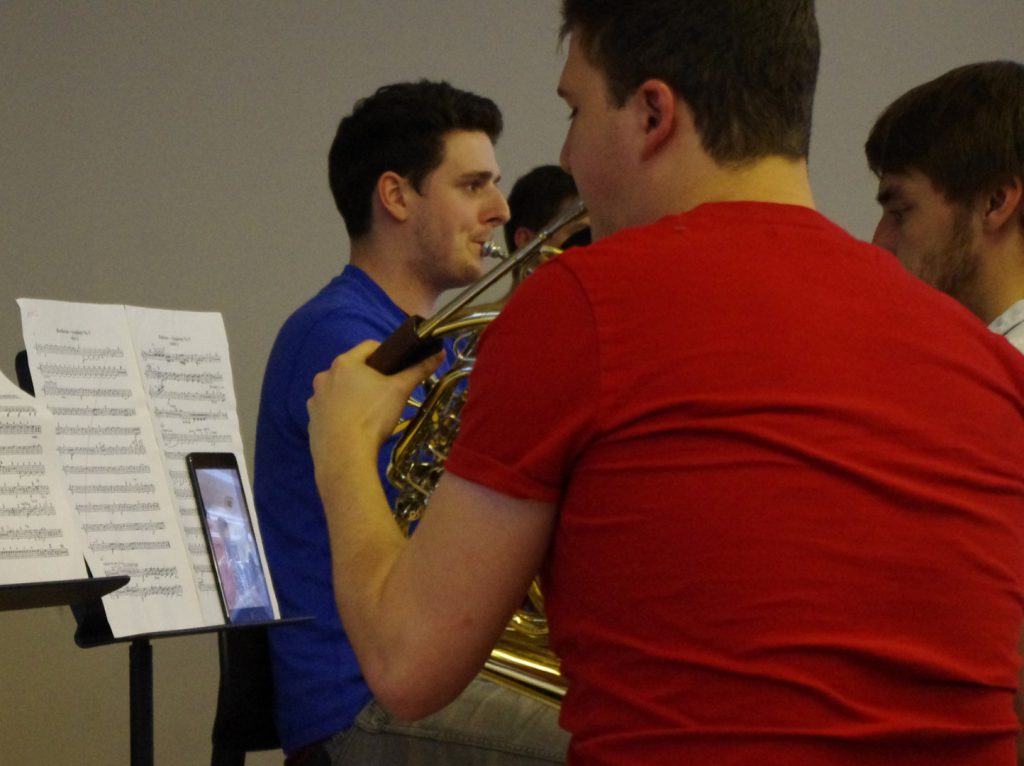
Preparations and test recordings
The RCM sessions began by playing the original 78rpm disc pressings of the Beethoven symphony from 1914 on a horn gramophone of the period.[33] As well as demonstrating mechanically reproduced sound, the playback served as a reminder that these records (and the ones we were about to make) were designed to be played on such technology with all its inherent limitations and advantages.[34] The original pressings were also recorded as digital files via a separate turntable and these were used for comparison purposes, to gauge the level of the newly recorded wax discs against the original recordings and to compare the overall balance of instrumental sections.
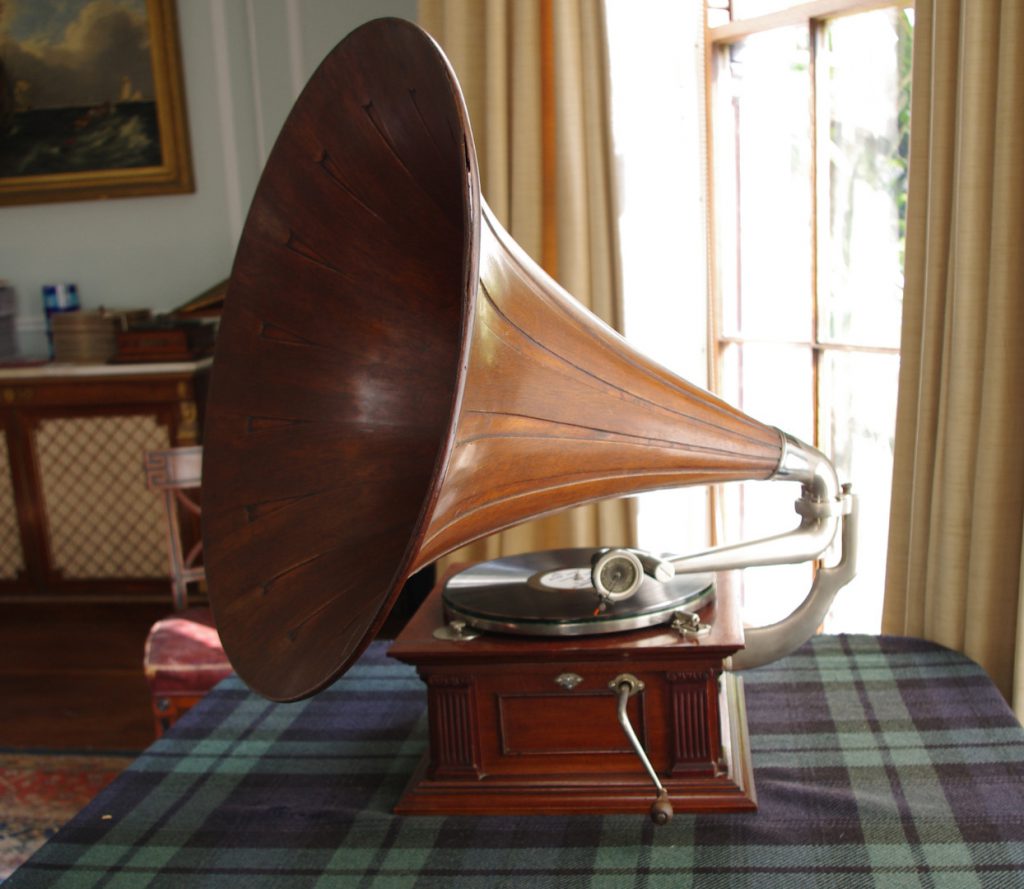
Once the physical arrangement of musicians had been established in front of the recording horn and the music sections rehearsed in these unfamiliar positions, selected music passages were recorded on to the wax discs for test purposes. Recording tests were made on the first day until we were able to establish the final positions for the orchestra and an acceptable level of amplitude on the recording. The making of test records was very much a part of the process during the acoustic era also, as there was no means of monitoring the recording other than by listening through the horn with its narrow end placed in the ear. While this might give an indication of the sound reaching the recorder diaphragm, it cannot predict the quality of the recording and is impossible to do during the act of cutting a record. By making numerous test recordings, we were following a customary mode of procedure established by the early acoustic studios (Chapple, 1928, p 293; Harvith and Harvith, 1987, p 43; Melville-Mason, 1977, p 97).[35] The second day was devoted to recording the two movements on four sides as well as making additional versions for a later electroplating and duplicating process.[36]
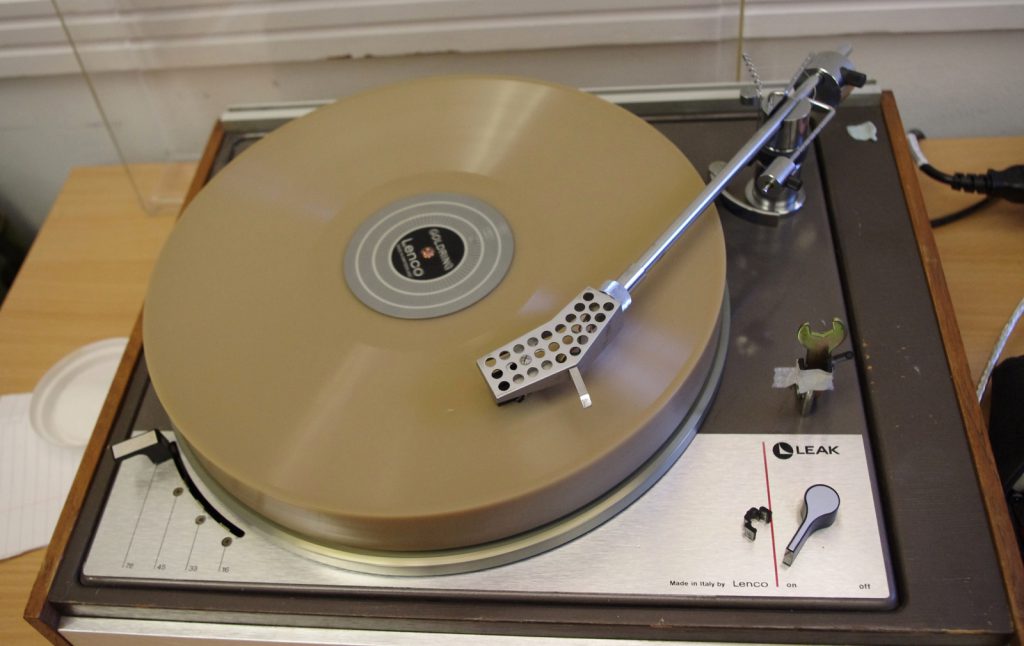
A note on interpretation
Because the focus of the re-enactment was on the technical aspects and the playing experience, no attempt was made to follow Nikisch’s interpretation of the symphony.[37] Instead, conductor Robin O’Neill led his own interpretation of the symphony.[38] Only the first and second movements, the Allegro con brio and Andante con moto, were recorded for the RCM re-enactment. Likewise, while the BPO followed the contemporary German tuning system of A=435Hz, the RCM Orchestra was tuned to a modern-day A=440Hz.[39] Nor were period instruments used or stringed instruments strung with gut strings. While the RCM re-enactment was therefore not an authentic reconstruction in terms of musical style, it did allow us to hear how a modern orchestra would sound when recorded using the acoustic process.
The RCM acoustic recordings followed exactly the same side-breaks as the original discs. Nikisch’s version of the first movement is taken at an unusually slow tempo, and omits the repeat of the exposition. Had the repeat been taken at this tempo, the first part of the Allegro would not have fitted on the record side. The first side of his Andante is also unusually long and at five minutes it barely fits on a side of a twelve-inch record at 78rpm. The centre label of this side is half an inch smaller in diameter than is standard and the music stops right at the end groove. In conductor Robin O’Neill’s interpretation of the Allegro, the exposition is repeated, except in a shorter version of the movement, which was recorded for electroplating purposes, to enable the moulding of a ten-inch resin record playable on a gramophone.[40]
Unlike the original Nikisch recording where the entire symphony was recorded in one day, the re-enactment took two days to record two of its movements. The first day was almost entirely taken up with establishing the orchestra’s positions, adjusting the recording equipment and making sound tests to establish the optimal recording set-up. However, long periods of experimentation during recording is entirely commensurate with the studio practices of the acoustic era where recording tests were being performed on a daily basis (Batten, 1956, p 34). The second day was devoted to recording each movement on two wax discs.
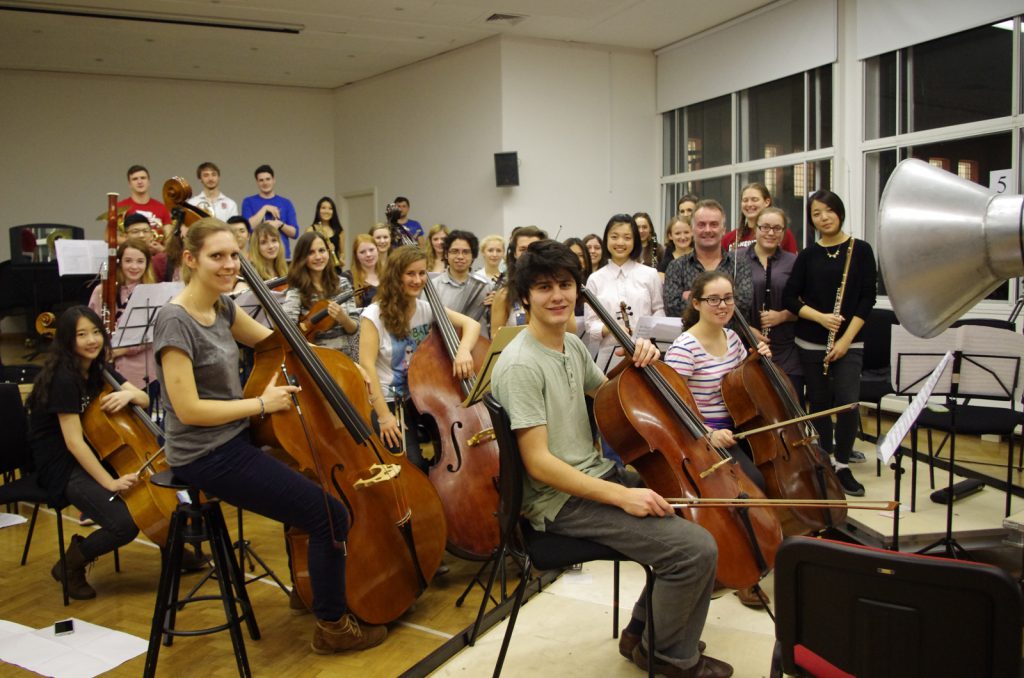
Section 2
https://dx.doi.org/10.15180/150302/004Findings from the perspective of sound engineering: preparation and processes of acoustic recording on disc
Surviving documents, photographs and first hand accounts relating to acoustic studio practices tell us little about the precise methods of recording, which were shrouded in secrecy and had been largely developed through tacit knowledge.[41] Formal portraits were taken of artists and experts alongside the recording horns, but the recording apparatus, the ‘business end’ of the horn, remained hidden in a closed booth or out of shot. In order to fully understand how an orchestral recording could have been made acoustically, it is therefore necessary to reverse engineer the process of acoustic recording, using the same apparatus or constructing replicas of it, and to recreate the recording media itself – the recordable wax discs.
The following section examines the processes, technology and media of acoustic recording from the perspective of the project’s sound engineer who, in addition to making the recordings, was also responsible for the manufacture of the blank wax discs and the construction of the replica recording horns, disc recording lathe and recorders.
The primary component parts of the recording apparatus and media are discussed individually and their performance assessed, beginning with the manufacture of the all-important wax discs for recording. This is followed by a description of the recording lathe, which consists of a powerful turntable on which the blank discs are rotated and an advancing mechanism (or feed screw system) which in this particular design propels the turntable underneath the stationary recorder and also regulates the ‘pitch’ (the number of grooves per inch on the record). The sizes and shapes of recording horns that were used to collect the sounds to be recorded are described, followed by an examination of the recorder that is connected to the horn and receives the sounds. The recorder consists of a sealed chamber that houses a circular diaphragm, typically made of mica or glass.[42] The sound energy received from the horn vibrates the diaphragm and these vibrations are transmitted to the stylus that cuts the spiral groove on the disc via a linkage from the centre of the diaphragm.
The section ends with an account of how some of the recorded wax discs were processed and duplicates made from them that could be played back on a mechanical gramophone.
Wax disc preparation
The recording medium was of fundamental importance to the project, since the re-enactment would be assessed by the sound reproduced from the discs. Therefore, the first major technical task was to reproduce the wax disc blanks that were used for recording in 1913. Wax recording is a lost art and careful research and practical experimentation were required to replicate as closely as possible the discs of the time. Since most of the formulae for the waxes were commercial secrets and the actual wax blanks were an industrial intermediate, access to original recording wax is very limited. The material would have been recycled when in use and then scrapped, either when the recording company ceased to trade or when it went over to lacquer/nitrocellulose masters.[43] A chemical analysis of any original wax will indicate some of the final components but not the method of manufacture or the exact raw materials used to produce them. Very often the quoted recipe in published material is wrong or misleading, or the materials have changed and current versions of them are produced from different sources or by ‘better’ methods that remove essential components now considered as impurities. In fact these ‘impurities’ often imparted vital qualities to the finished recording blank.
Blended waxes versus soap waxes
Contemporary descriptions of wax masters hint at the material being a blend of waxes, and certainly such a blend would be a quick and desirable way to make a blank. Blended wax would also allow for easy adjustments in the cutting characteristics of the disc. However, a search of the literature for this type of wax produces few credible references (Barnes, 1936). In The Reproduction of Sound (1916, p 37) Henry Seymour alludes to a mixed non-soap wax made in Germany. However, the current author’s many experiments with both original and modern waxes have failed to produce a blended material that comes close to a usable wax in this way. Blends tried included various proportions of montan, carnauba, paraffin wax, and petroleum jelly. In most case the waxes are not totally miscible and separate on cooling, giving crystalline patches, and they produce a material which is either too soft or too brittle and always inherently noisy when cut – if they can be cast into blanks without splitting on cooling. H Courtney Bryson does not mention this material in his 1935 book Gramophone Record. He does suggest a mixed wax, but this uses pre-made soap components as well as waxes.[44] Preparation of this blank recording material becomes particularly difficult when trying to define the actual composition of the aluminium oleate, a key ingredient which, according to Bryson, is a brown jelly-like material. However, when recently prepared from pure ingredients, it precipitated as a white putty-like substance. This material was at one time an item of commerce and used in some grease formulations and it is difficult to reproduce a modern analogue.
A small sample of later Gramophone Company wax, analysed by chemists at Kings College London, shows that this was a soap wax, containing a wide range of other hydrocarbon compounds. This suggests at least one of the components was a complex natural or fossil wax, but no conclusion could be reached and without access to the original ingredients it would be difficult to replicate the wax from the chemical analysis alone. These waxes often contain montan wax as a saponified or non-saponified ingredient (and sometimes as both), the major saponified component being stearic acid. The chemical specification of montan, stearic acid and some other ingredients for these waxes has changed in important but subtle ways since the 1920s. Many of these extraction and production changes have happened since the 1960s and some of the materials have become commercially unavailable.
Internal documentation by the Columbia Graphophone Company in 1931 gives a specific process and recipe.[45] However, duplication of the 1931 Columbia recipe with modern stearic acid (several grades were tried) and montan waxes (several types were tried) produces a material that is far too hard compared with the requirements of the disc cutting process and also compared with the original wax sample. Disc blanks require 2.5 to 3 kg of wax per blank and around 25 blanks were needed for tests and takes. A saponified wax with as close to the characteristics required as possible was developed and tested. The material could be compounded in one of two forms – a basic wax which would need to be used at a higher temperature, or a modified version tempered with a softening wax that could be used at room temperature. At the start of wax production it was not certain that a warming cabinet for the wax would be available for the re-enactment, so the tempered wax had to be used. The tempering wax can, at certain percentages, increase the cutter noise.[46]
The objective in producing a suitable recording wax was to match the cutter noise and thus the possible signal-to-noise ratio[47] of the original waxes. When analysed, the noise of the historical wax was 30dB lower compared with a 0dB signal level. After numerous test formulae, a recording wax was produced whose noise measured approximately 33dB lower than the signal. Analysis showed the newly made wax to be entirely consistent in quality to those that would have been in daily use in 1913.[48]
The wax was made in 20kg batches, cast into moulds, cooled, drilled, trimmed on the outside on one machine and then rough shaved on another. Once this was done, a second shaving machine could be fitted with a sapphire blade and the final surface produced. From raw material to final blank, each recording surface required from three to four hours of work, although after use the discs could be shaved for reuse.[49]
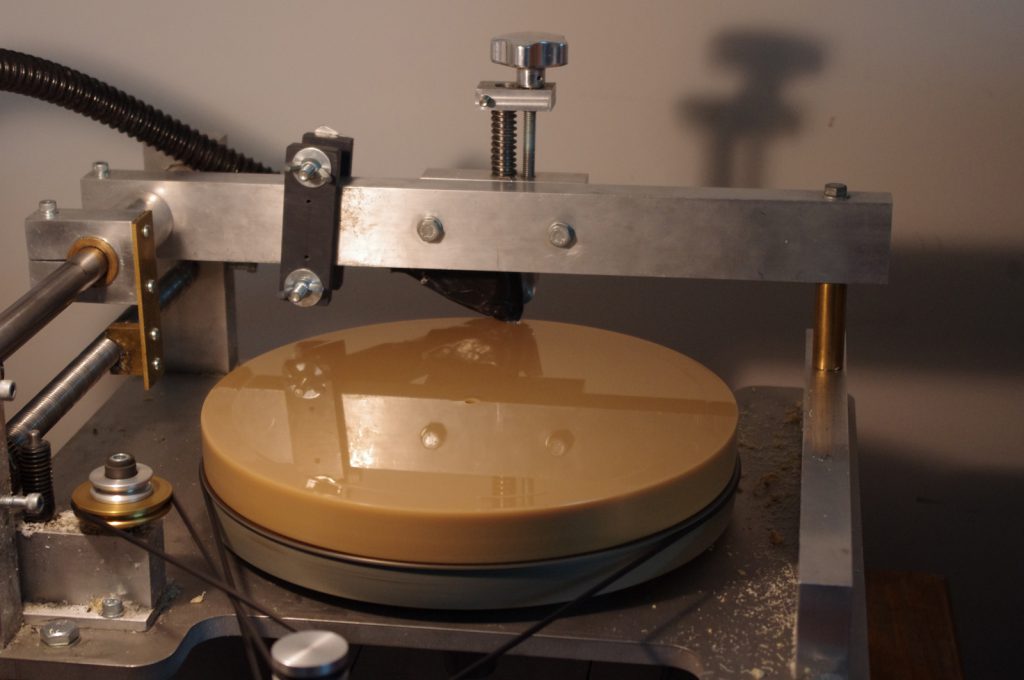
Session results regarding wax
The wax behaved consistently and it was possible to warm the blanks and shave them on site during the sessions. Fully warming the blanks took several hours. The warming cabinet had a capacity for six blanks so the number that could be made ready at any time was limited. Maintaining the surface temperature could have been achieved by adding an overhead heat lamp to the lathe but this was not available so it was essential that recording commenced as a soon as the blank was on the turntable.
The playback of the waxes on the modern turntable still affected the soft groove to some extent and the early tests especially had a poor signal-to-noise ratio. This turns out in hindsight to have been due to the low level of recording rather than an especially high level of cutter noise. Noise and imperfections in blank wax records were regular problems in acoustic recording, with contemporary reports of entire sessions being abandoned and recording masters and the negative metal copies produced from them frequently rejected (Batten, 1956, p 35).[50]
Recording lathe
The specially constructed acoustic recording lathe was designed to use the traversing turntable system.[51] This was especially important where a large recording horn or a group of horns might be needed, as the movement of the horn(s) would put strain on the lead screw’s driving unit and would also cause the horns to point at a different angle at the start and end of the recording, moving from right to left. This can change the balance of the recording.[52]
The turntable was belt-driven and the belt stretched over the entire circumference of the platter.[53] Similar belt-driven turntables on recording lathes were used by the Columbia Company in the 1920s. These have the advantage of transmitting no noise to the turntable shaft, which can happen with a bevel or similar gear drive. An electric motor with a high quality speed control was used in preference to the weight-driven motor that would have been originally used as the weight motor would have been too expensive to build and would have added unnecessary bulk to the equipment. The lead screw was driven by a suitable motor giving the possibility of a very wide range of feed pitches as needed.[54]
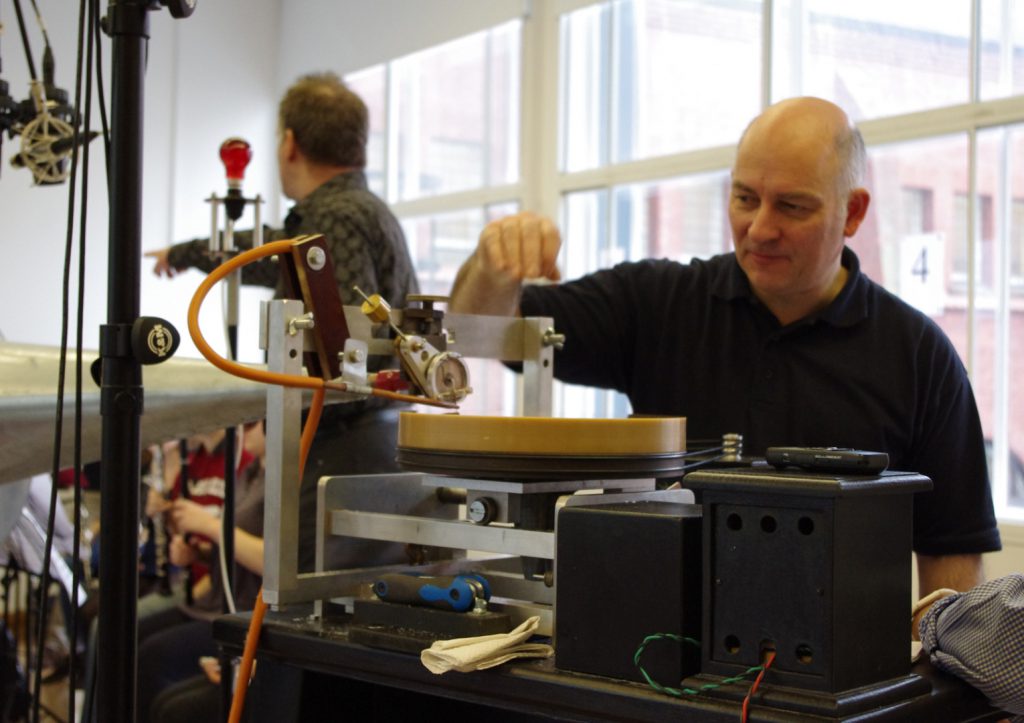
The machine was designed to be mounted on a stand that would bring the horn up to a working height – normally head level for a standing vocalist. The transport system of the lathe performed consistently throughout the sessions.
Recording horns
While not revealing the interior of the recording booths, historical photographs do show the recording horn, sometimes with one or two additional horns fixed to it, the narrow end of which is attached to a recording soundbox via rubber tubing. ‘Couplings’ or tubing that connected auxiliary horns to the main recording horn would have a narrower bore that attenuated the incoming sound of instruments, enabling a soloist, for example, recording through the main horn to remain in the foreground of the recording.[55] Multiple horns, their couplings and the positioning of musicians in relation to the horns were the means of sound balancing or ‘mixing’ during the acoustic era.
Only a single horn is visible in the 1913 photograph of the BPO in the recording studio, but additional horns used in the sessions may have been removed for the photograph, to allow room for the camera equipment or to avoid blocking its sightline. Using multiple horns for recording has the advantage of isolating and balancing groups of musicians and is ideal for recording soloists with accompaniment, but a disadvantage in that it reduces pressure at the recorder diaphragm, resulting in a lower level of recording.[56] For the recording experiment at the RCM, it was decided that a single recording horn should be used throughout and no experiments with multiple horns were attempted.[57]
It should be noted that most of the sessions that exist in the photographic record, where two or more horns were used, normally consisted of small orchestra arrangements where the principal players were positioned close to the mouths of the horns.[58] There may be two main reasons for this approach; one would have been to reduce the expense in musicians’ fees and the other would have been the typical size of the studios at the time.[59] As a result of this project, it has become apparent that increasing the number of players may well increase the orchestral quality of the sound but moves many of the quieter instruments much further from the recording horn, giving a reduction rather than an increase in overall recorded level.
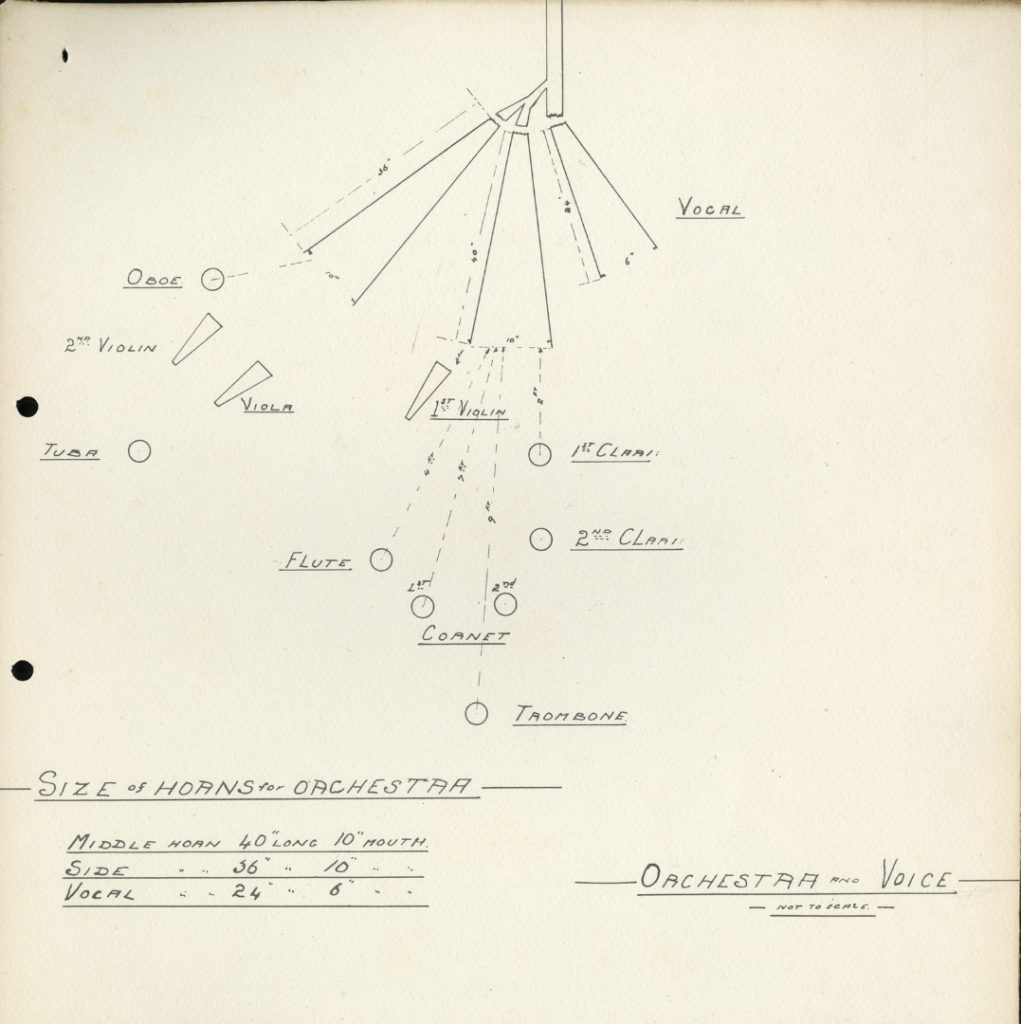
The taper of gramophone recording horns were generally 1:4 so that a forty-inch long horn finishes at ten-inch diameter.[60] Four such horns were specially fabricated for testing during the RCM recording sessions: two 40-inch (length) x 10-inch (diameter) horns made from sheet zinc (0.7mm thickness); a slightly larger straight horn made from galvanised sheet steel (0.7mm thickness); and a flared horn made from the same material.[61]
Session results regarding horns
Both the straight and flared horns were tried without changing the initial set-up of the orchestra, the flared horn providing significantly better results. Between sessions it was possible to do a voice test to establish the areas of the room that were effectively covered by the horn for the purposes of recording. With the flared horn the sensitive workable area corresponded directly with the extension of a cone of the same angle as the main part of the horn. A secondary, less sensitive working area was represented, roughly, by the extension of the cone flare angle. Areas outside these two cones were effectively dead, meaning instruments outside this area hardly registered at all. The effect was far more evident than expected and the floor was marked with tape to show the workable areas, thus allowing for rearrangement of the orchestra.
Recorder options
At the start of this project, two duplicate Gramophone Company-style recorders were available. These had been made in 1997 to facilitate a historic recording celebrating the centenary of HMV, the oldest company within the EMI group, and had been used to successfully cut both lacquer and wax masters of tenor vocals with piano accompaniment.[62] The recorders were replicas of the so-called type ‘R’ recorders,[63] and once the rubber gaskets were replaced to ensure an air tight seal with the correct amount of resilience around the edge of the diaphragm, the performance of the recorders’ voice tests was found to be consistent with the original set-up as used in 1997. According to documents at the EMI Archive, this style of recorder was also in use in the 1907–08 period for military bands and small orchestras[64] and they were still in use up until 1924. There is no direct evidence that these standard-type recorders were the ones used in Berlin in 1913, as no surviving documentation exists from the Deutsche Grammophon Berlin studio, but it is a reasonable assumption.[65] The diaphragms used were mica, with a diameter of 42mm, and a thickness of 6.5 1/000 inch for one, and 7 1/000 for the other. Flat rubber gaskets were used for both. The author’s previous experience showed that diaphragms thinner than this will produce a ‘tubby’ sound with reduced top frequency response and that thicker diaphragms will considerably reduce the sensitivity and low frequency response.
There was a possibility that for orchestral use a larger diaphragm would be more suitable, and another type of recorder was made specifically for the RCM re-enactment with the capacity to hold a 50mm diameter mica diaphragm. Both types of recorder were tested during the first day of the re-enactment to determine which would most closely approach the quality of the original recording.
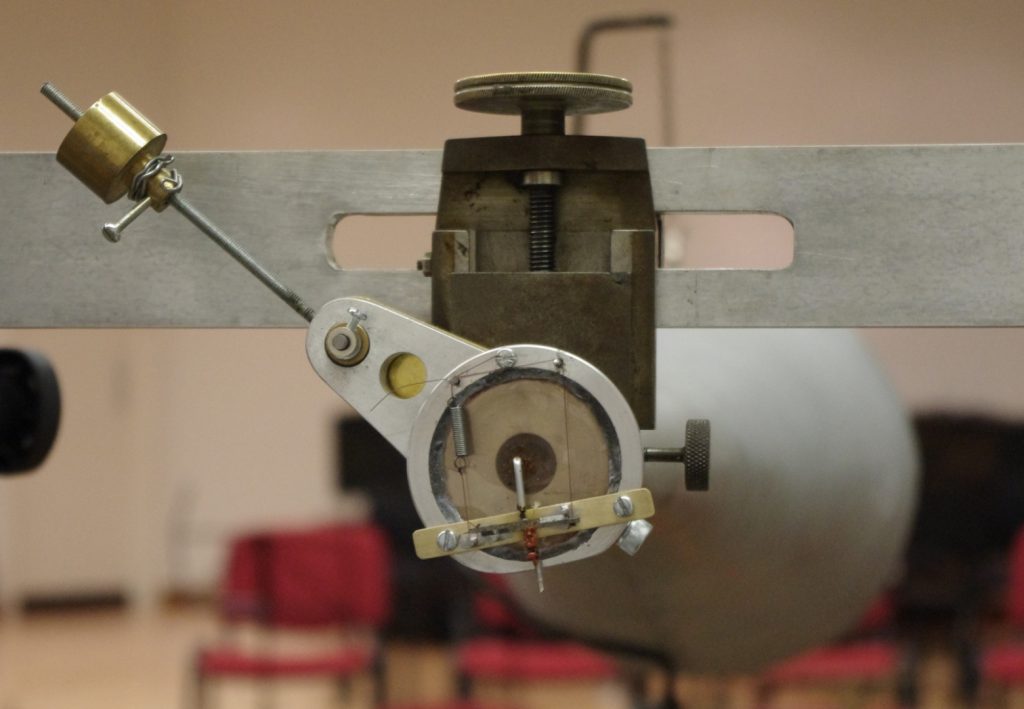
Session results regarding recorders
Two things that affect the recording process are the freedom of movement of the recorder up and down, and the air-tightness of the seal on the rear of the recorder box. When tested, the two type ‘R’ recorders were insensitive compared with the new recorder and because of this the main recordings were carried out with the 50mm diaphragm unit.
One of the 48mm units was fitted with an aluminium diaphragm but in a test this increased cutter noise and was very resonant in response. In fact, a flat response is the desired result, as a resonant response causes certain frequencies to record much louder than others, giving an unnatural sound to the finished recording.[66]
The new 50mm recorder did present some problems with the slight rise-and-fall that can occur in each revolution of a recording blank. This causes what is termed ‘sweep noise’ in the recording, a cyclic rather than constant background hiss.[67] It was possible to improve this with some on-site adjustment, although a certain amount of re-working, with access to workshop machinery, would have been desirable to eliminate the effect. As this is a type of recorder that floats on the wax, its inertia and that of its trunnion need to be as low as possible.[68] Simply offsetting the mass with a counter-balance does not automatically solve the problem. Nevertheless it was the better option for the recording.
Time was the limiting factor as the substitution of diaphragms into the recorder boxes would take around 15 minutes each time plus the recording test. Glass diaphragms were not at this stage an option for this re-enactment as they have to be specially made to size and thickness. Mica is practical because it can be made to a specific thickness and cut to size with ordinary workshop tools.
Processing the recordings as 78rpm discs
During the recording sessions it was decided to make a limited number of recordings that would not be played back in any way on the day but would be turned into discs. This would give the opportunity to play copies on a gramophone, thus replicating the full cycle of processing of the original 1913 recording.[69] To this end the wax was tested in advance so it was known to be proof against the plating-bath solution allowing for the possibility of subsequent processing.
To create a more permanent disc after the recording session a few of the wax masters were treated with graphite to render them conductive and then processed in a copper plating bath to deposit a layer of copper around 0.75mm thick. This process takes around thirty hours. Once the wax was separated from the copper shell and the surface cleaned, it was possible to use the shell to produce accurate resin mouldings. The mouldings produced are similar in hardness to a shellac pressing and with the right type of needle[70] it is possible to play the recording back on an acoustic gramophone and get a good idea of how it compares with an original 1913 recording played back on the same equipment. This is important as the mechanical playback has a particular natural filtering characteristic.[71] In addition, a copper shell is an archival item in comparison with a wax blank, which tends to deteriorate in storage.
Resin mouldings of the RCM re-enactment were produced and replayed successfully. In this way the entire acoustic recording and production processes were replicated.

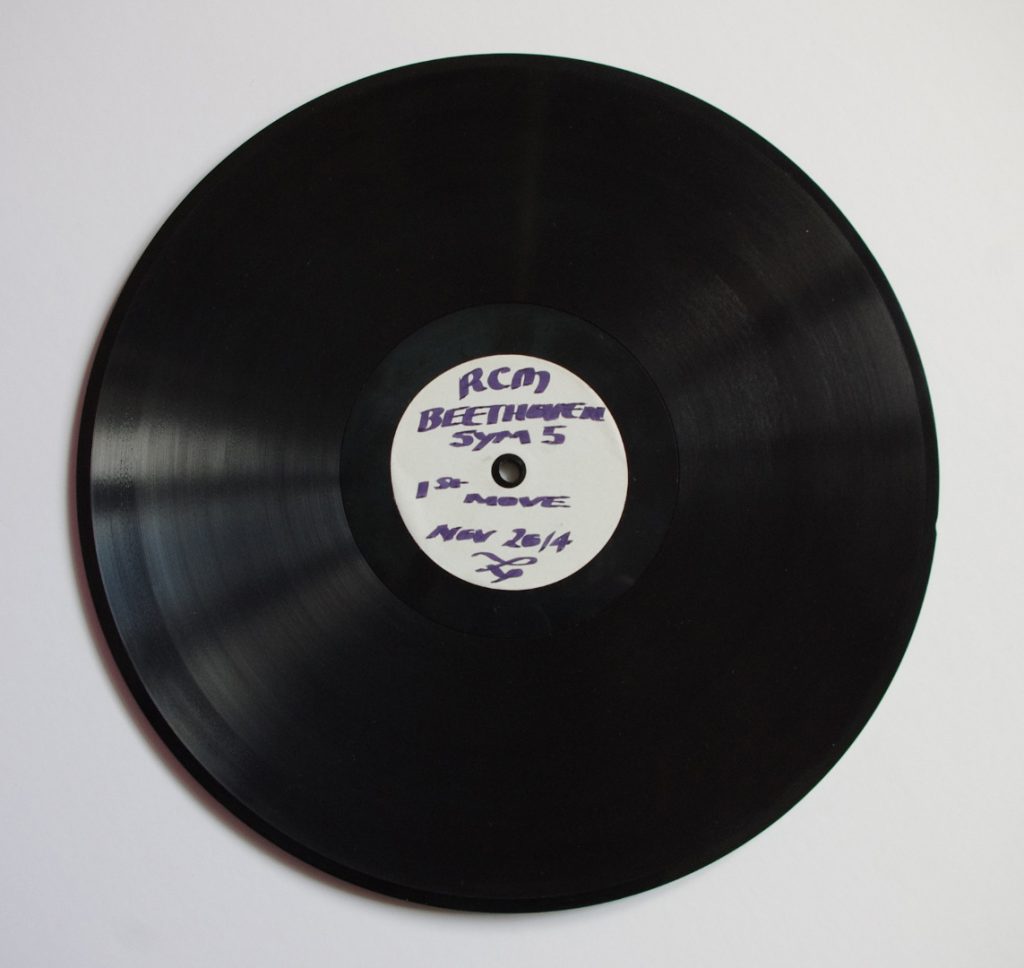
Assessment of the results
All the primary components of the acoustic recording system that were constructed for the re-enactment performed well throughout the testing and recording sessions and were analogous to those used in the acoustic recording studios from the early 1900s.
From a technical point of view, the sessions at the RCM have clearly demonstrated that the original recordings by the BPO from 1913 under both Hertz and Nikisch were pushing at the very limits of the acoustic recording system of the time, in terms of what it was possible to capture sonically using recording horns. The larger the group of musicians in the studio, the more difficult it becomes to balance the instrumental sections and maintain a satisfactory overall recording level as many of the musicians are placed further away from the recording horn. Even the later orchestral acoustic recordings from the 1920s, when compared with earlier military band versions of the same piece and even from the same studio, are generally recorded at a significantly lower level.[72] To get the recording level up and keep the noise level down requires everything to be just right; every single element has to be optimised.
By the end of the sessions at the RCM, we had managed to increase the level of recording and improved the instrumental balance. While the recording levels were at best 10dB lower than that of the Deutsche Grammophon 1913 recording, the technology and media were refined as closely as possible to match the historic antecedents. Importantly, in the process of experimentation, the factors that would in all likelihood have allowed the recordings to reach the historic levels were identified.[73] The experiment has provided valuable information for future research into the practices of acoustic recording.
Section 3
https://dx.doi.org/10.15180/150302/005Recordings – a way of learning about, and from, the past: Introduction
‘The past is a foreign country; they do things differently there.’ (Hartley, 1953, p 7). In the case of early recordings, the question has been: But how differently? What are we hearing? A central question underpinning these experiments is: What performance lies behind an early-twentieth century acoustic recording? What was happening behind the hiss and crackle of the disc, and what effect did the limited technology have on the performance that was being recorded? This question has been widely speculated upon by musicians, academics and listeners, but through the re-enactment it might be possible for the first time to discover much more specifically what an early orchestral recording represents.
The re-enactment afforded three main ways of answering the overarching question posed above. The first was to make an acoustic recording whilst simultaneously capturing the sound in the room using modern digital recording technology, thus allowing a comparative listening analysis of the two different recorded outcomes. The second was to assess whether musicians had to adapt their playing style for the acoustic recording process. This was done via ethnographic observation and documentation of the rehearsal and recording processes, along with interviews with the musicians, and an analysis of the recordings captured over the span of the project. The third method was that with the results of these two types of investigation in hand – the differences between the modern acoustic and digital recordings, and the factors which affected the modern musicians’ performance – it would be possible to attempt an extrapolation of what the Berlin Philharmonic may have sounded like behind the extant artefact of the 1913 acoustic recording. Based on a preliminary analysis of these newly captured sources, this section will present the working conditions and general opinions of the participants, provide a brief outline of these three main aspects of the research and conclude with a consideration of what the student participants learnt from this experience and whether the experiment was educationally useful. The picture that emerges indicates that not only does a re-enactment of a historical recording help musicians to learn about the past – which implies a detached, purely historical point of view – but it also allows them to learn from the past; to look at the practices, performances, and issues of the past in order to question and inform their current working practices and aesthetic standpoints.
Research methods and preparation
For this re-enactment experiment it was important to prepare the students at the Royal College of Music for the performing style they were going to encounter on the Nikisch recording, and the process they would go through when making an acoustic recording. The musicians were provided with access to the Nikisch recording, attended a preliminary meeting, and were given an information pack containing details of the project’s aims, reading to contextualize this recording process, and information about the recording conditions and research process.
The role of the current author as stylistic adviser and co-researcher was to observe and document the process, conduct interviews with the participants, and undertake the comparative analysis of the sound recordings captured. The data was collected using ethnographic methods which included fieldwork observation of the rehearsals and recordings session, documented by video and audio recording and the taking of field-notes. In addition, semi-structured interviews were conducted with a cross-section of participants before, during, and after the re-enactment; these were also captured on video and audio.[74] The interviewees self-selected and participated on the basis of availability and preference, and all the normal ethical considerations were in place for the project.
Setting the scene: general impressions of the musicians’ experience
In order to give some context for the musical comparisons that follow, it will be useful to provide a picture of what this project was like for the participants. Preliminary findings from interviews indicate that, in general, the postgraduate and undergraduate students that made up the RCM Chamber Orchestra were very interested in the project. Some knew more than others about acoustic recording and the performance style they would encounter on the Nikisch recording, but they seemed to be aware that this was a unique opportunity. The students worked diligently during the recording sessions, which were clearly hard work – the conditions were hot, cramped and intense, and at times rather boring as they had to do a lot of waiting while the recording technology was prepared and tests were being undertaken.[75] Even though the room was bright and airy, the temperature had to be kept much warmer than was comfortable in order to keep the recording wax warm and malleable, and the musicians had to crowd together to be within range of the recording horn.[76] Despite the difficulties of the situation, the musicians said that they found it a fascinating experience – to record in such intense circumstances and to hear themselves through the medium of acoustic recording was even more interesting than many had expected.[77]
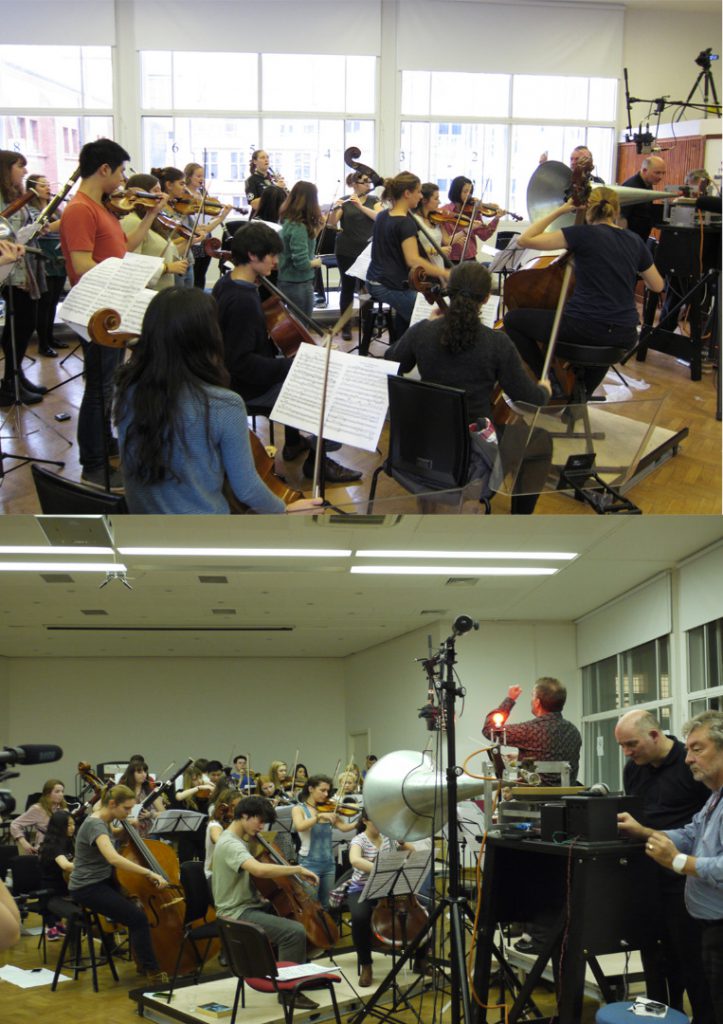
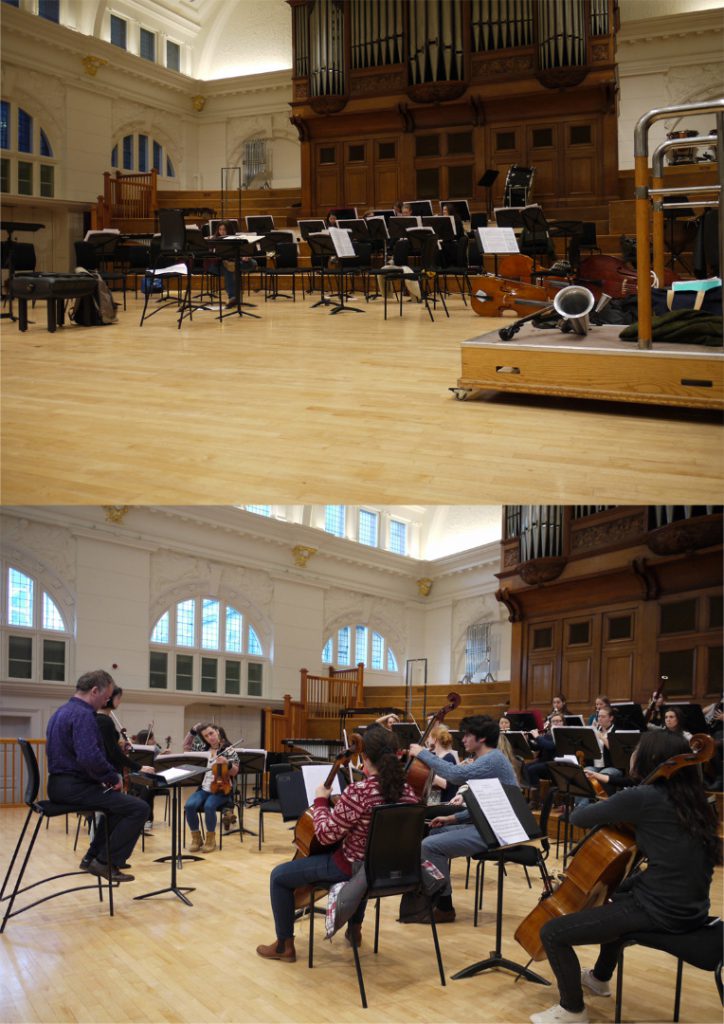
Some members of the orchestra found the significantly different orchestral positioning quite difficult, which is hardly surprising considering how inverted some of the seating was. The lower strings were to the left instead of to the right, with the double-basses in front of the cellos on the first day, though the final positioning was with the cellos on risers closest to the recording horn with the double basses directly behind. The woodwind were off to the right, with the bassoons on the opposite side of the orchestra, and the horns were facing backwards in order to point the bells of their instruments towards the recording horn, meaning that they had to look at the conductor in a mirror or on their iPads in ‘selfie’ mode.
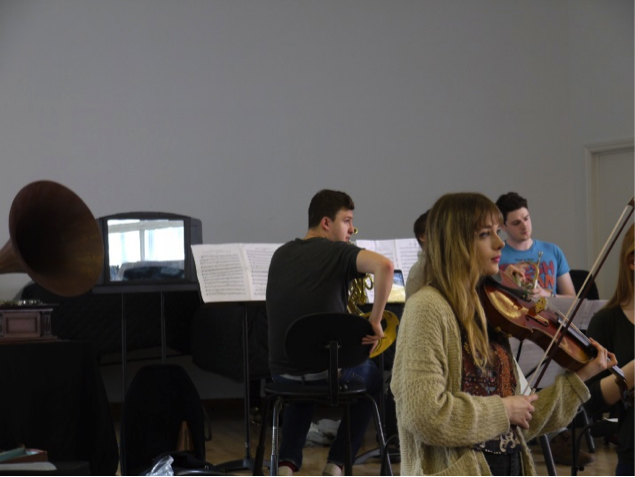

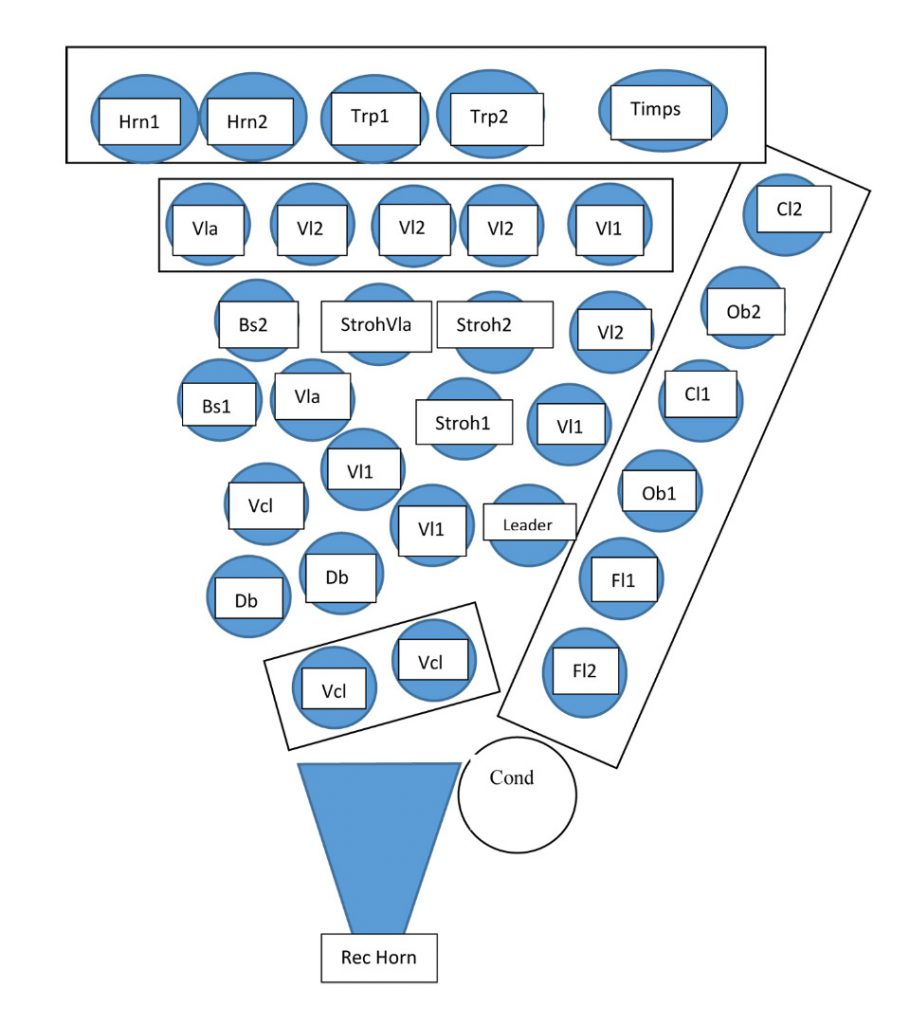
However, others loved the new positioning. A double-bassist[78] and first-violinist[79] very much enjoyed being so close together for a change, with the immediacy of hearing the bottom and top lines so closely paired, instead of being at opposite sides of the orchestra. More generally, the students found themselves questioning the concepts of modern practices of editing and the current preference for perfect recordings. Many, contrary to their expectations, loved the focus and energy of these one-take unedited recordings,[80] finding them more akin to live music-making.[81]
Acoustic versus modern digital recording techniques
The performances in this project were recorded using two technologies simultaneously. Digital microphones (a mono microphone and a stereo pair of microphones) were hung above the acoustic recording horn to capture the sound in the room as well as the sound picked up by the acoustic technology. In this way it becomes possible to compare and extrapolate what is and is not captured on early acoustic recordings. People interested in the performances from the first part of the twentieth century often apply caveats when discussing the sound of acoustic recordings, such as that the recordings are of poor quality. Jon Tolansky describes the Nikisch recording in these terms, calling acoustic recordings ‘primitively made discs’ (Tolansky, 2003, p 141). It is suggested that only a limited range of frequencies could be captured, resulting in a recording which was an unrealistic impression of the performer. Timothy Day suggests that soprano voices became ‘plaintive, or ethereal, distant’, and basses could sound ‘hollow or wooden’ (Day, 2000, p 9). Robert Philip describes that ‘little of the power of the (reduced) Berlin Philharmonic came through’ in the Nikisch recording being considered here (Philip, 2004, p 28). Others have said that musicians had to significantly change their performance in order to get the sound across for the recording, thereby implying that early recordings are not representative of what really happened. However, with these new sources for comparison, it is possible to examine what is lost or changed, and what carries through the technology.[82]
What is the difference in the sound of an orchestra when it is recorded acoustically compared with when it is captured by modern technology?
Apart from the obvious addition of the familiar ‘retro’ sound of hiss, crackle and the record turning on the turntable, there are several aspects of the sound and representation of specific performance traits that are affected. A more detailed description of the comparisons is given below, but in general it can be said that the two versions are very different, but also very similar. Subtle details change, but the quality of the performance, the ‘voice’ of the performance, the essence of what is being communicated, is the same. In a 2015 BBC documentary the singer Patricia Hammond heard herself played back from wax cylinder on a phonograph for the first time and exclaimed: ‘That’s like listening to the great-great-great grandmother you never had, who was a singer! That’s extraordinary!’[83] The implication here was that you can hear something that is recognisable as yourself, or related to you, but with an overlaid patina of time – like hearing yourself in sepia tones.
Did musicians change their performance style for acoustic recording?
To what extent did early recorded performers have to change their performance style to come across via acoustic technology? Stories abound of singers with their heads stuck in recording horns, or having to leap back for the high notes and loud passages, or people saying that a great artist’s performance lost its magical quality when recorded.[84] Mark Katz suggests that the rise of continuous vibrato in violin playing is due to recording requirements. He posits that ‘a constant and strong vibrato became increasingly useful for concert violinists who made recordings […] [because] it helped accommodate the distinctive and often limited receptivity of early recording equipment’ (Katz, 2004, p 93). He further argues that ‘Many performers learned to internalize the necessary adjustments by controlling their singing or playing to suit the limitations of the technology’ (Katz, 2004, p 39). The re-enactment provided a microcosm to look at in order to see whether anything about these modern musicians’ playing changed in reaction to the acoustic recording conditions. The simple answer is that it did. But the caveat is: perhaps not as much as might have been expected, or previously assumed. The findings from the session are still preliminary, yet they help to draw out some themes which will be more carefully examined as the analysis progresses. In the initial rehearsals, the focus was the same as it would be for a normal concert or modern recording – the conductor Robin O’Neill concentrated on achieving a nuanced, detailed performance, with subtle gradations of dynamic and clear ensemble. However, after the first acoustic playback, it became clear that certain things would need to change. Given below are the first movement on the first day of recording, and then one of the last takes on the last day. One can hear the subtle differences in various aspects of the playing style (the digital sound in the room has been used in order to hear as much detail as possible).[85]
After the first take, the conductor immediately started talking about the articulation needing to be shorter and more focused – ‘not “ta da da woh!” but “ta ta ta dam!” Shorter!’[86] The balance was also identified as being a problem, and therefore the cello section was moved back from their position in front of the recording horn and the double basses were brought closer. After the fourth take the conductor said that the orchestra needed to produce more sound, be more expressive, and play with more clarity, he said: ‘Contrary to what we do in a normal concert hall; extra intensity on every note.’[87] Changes in elements of the performance that were observable during the fieldwork included: the playing became more overtly characterised, more expressive or extroverted; overall the dynamics became louder, the quieter dynamics were lost as the whole spectrum shifted to the louder end; the articulation became more defined, picked out, with less legato playing; the attack was more aggressive, with strings playing more into the string (moving from a portato stroke on the first day to a marcato stroke on the second); there is a more intense vibrato used in the strings; the tempo is markedly quicker (starting at minim equals 92 on the first day and accelerating to minim equals 97 by the second day); and the tuning was sometimes compromised because at times the musicians were pushing very hard to produce the required dynamic level to create the necessary sonic impact for the recording. However, the overall effect, intention or ‘voice’ of the performance remained recognisable. One can hear that the same people are delivering that message or particular quality of utterance.
The second movement offers another comparison; these examples are of the clarinet solo from bar 49 onwards.
In the first instance the orchestra are playing in a relaxed manner, there is a subtle, mezzo-piano clarinet sound, and an easy legato melody in the cellos. The pizzicato in the strings is quite demure, and the gradations of the dynamics throughout the orchestra are subtly differentiated. The general effect is much more pastoral, and the violin entry is delicate, with the bass line being subdued and less sustained. By the second day various changes have been made. The clarinet solo is played at a louder dynamic with a more forward presence, whereas it had previously receded into a sotto voce mode after the first moments of the entry. The woodwind sound is much fuller, and the overall string sound is much more active throughout. The violin entry which before had been delicate is now louder, fuller, more intense, with more vibrato and played more into the string, and the bass line is more solid and sustained. Whereas the dynamic marking in the score is mainly piano with only a few variations away from this, this performance on the second day is generally presented in an emphatic mezzo-forte.
The perceptions of the musicians corroborate many of these points. Most of those interviewed pointed out that they very consciously had to play louder, and as a result many finer details were lost. Some were frustrated that the rehearsals had been about detail and subtler dynamics, and then in the end they just had to whack out the sound;[88] the double basses had to be especially aggressive and exaggerate their dynamics and attack. One described that they were having to focus on ‘balance, intonation, articulation, and ensemble’.[89] Many noted that they had to project their sound and articulate more clearly. One called it playing in a way that was ‘precise and a bit brutal’.[90] Others, such as the woodwind section, perceived they had to play with more legato and more vibrato at times.[91] Some were shocked at how different the balance on the acoustic recording was, and what they had to do in terms of the positioning in the room and the playing style to get the desired result on to the disc.[92] One musician described it as ‘a battle’[93] just to get something down on the wax, whilst another described it as ‘reality without diplomacy!’.[94] However, others felt that they did not need to change very much about their performance at all – that the altered positioning achieved the desired result.[95] This varied depending on the instrumental group to which the participant belonged and how it came across through acoustic recording. How differently are musicians having to play, and what effect is it having on the final recording? The picture that is emerging is that adjustments were being made in terms of positioning and performance in order to produce a sonic picture that resembled the sound musicians felt they made live. They were adjusting to achieve a sound that they could recognise as themselves. In the words of one participant: ‘It was contrived to be an accurate representation’[96] of their playing. Further analysis is needed, but it could be argued that even though the sound in the room had to be significantly different from their normal style of playing live, the recorded result was an attempt at an ‘approximation of realism’. This concept of ‘approximate realism’ will be explored further as the material is analysed in more depth.
Is it possible to extrapolate what the Berlin Philharmonic might have sounded like?
Having looked at how acoustic recordings affected musicians in the re-enactment, what might this experiment be able to reveal about the sound of acoustic recordings from the past? In order to attempt to cut through the noise – to listen through the recording – and try to extrapolate what the Berlin Philharmonic may have sounded like in that studio in 1913, it is necessary to do a thought experiment. This involves listening to the difference between the modern acoustic recording in the room and the acoustic recording, and then listening to the Nikisch recording and imagining what it would have sounded like in the room in 1913. A more calculated mechanism for this will be developed, but this should suffice to provide an initial impression.
Now one should try to imagine what the Berlin Philharmonic Orchestra might have sounded like in that studio on the day, or perhaps as one step further, live in the concert hall that night. One of our musicians said that after this experience she could hear the Nikisch better in her head.[97] The digital recording of this first movement presents an orchestra with a full, resonant and resplendent sound. The chords are sustained, as are the long notes. A full and continuous vibrato is audible in the strings, and the small short notes can be heard, as well as the bounce of the bow that creates the articulation of the main three-quaver theme. The chords in the woodwind section are clearly audible and distinct in timbre from the rest of the orchestra, and the brass and timpani sounds are also individually discernible. In the acoustic version of this performance, the whole tone is contained, shrunken down upon itself. The vibrato is ironed out, it is much less prominent. The long notes still sound sustained, but the short notes and chords do not resonate as readily. The violin tone sounds squeezed, and the small short notes, such as those in the three-quaver theme, are lost, or shadowy at most. In the tutti chords the differentiation of tone between the different instrumental groups is lost. The woodwind chords are indistinct, they are not easily identifiable as woodwind timbre, but subsumed into a general texture. However, the solo clarinet and flute lines in the second subject are clearly audible and come across well. The surges of the crescendo and decrescendo melodic lines keep their shape, though less of their intensity, but nevertheless they remain exciting. We can extrapolate from this that we can hear the ‘voice’ of the 1913 orchestra, the general impression of their performance. But we can assume that the Berlin Philharmonic delivered a far more nuanced performance on stage: quieter quiet dynamics, a fuller and more sustained string sound, and more nuanced phrasing. We can posit that the strings would have been playing with more vibrato, based on the amount that was lost in the modern-day acoustic recording, but it might be difficult to judge exactly how much more vibrato would have been in evidence in the room on the day. When we listen we have to make allowances for the fact that they were very probably exaggerating certain elements of their playing in order to get some things across to the recording horn. But the passion and excitement of their performance – despite the slow tempo that seems stylistically unusual now – do come across. It is possible to attempt a similar comparison for the 2nd movement.
The digital recording presents a sustained and lyrical viola and cello melody, with a resonant pizzicato from the basses, and a flute line that is played with a warm vibrato and rich sound. The overall string section tone is similarly rich and resonant. In the modern acoustic version, the vibrato is discernible, but it is subtle. It is possible to hear the lyrical viola and cello lines in terms of the direction of the phrase, but the colour in the tone is lost. The previous richness in the flute tone and overall woodwind tone has been somewhat ironed out. What is striking about the Nikisch recording is how resonant and lyrical the viola and cello melody sound, especially at the top of the first arpeggio (the third note), and the surprisingly full and luxuriant tone of the orchestra throughout. They must certainly have been making a remarkably resplendent sound in the room on the day, possibly aided by the use of a significant amount of vibrato in the strings.
What did the students learn? Was this experiment educationally useful?
It is useful, finally, to reflect on what these student musicians learnt from this process, how this kind of experience could be useful to students more generally, and whether this activity could be modelled for wider use. Many of the students, somewhat to their surprise, enjoyed elements of recording in this way. Of course there were difficult elements, mainly to do with the heat and difficult working conditions. However, they liked the necessary focus and the intensity of one-take recording, the fact that there was no safety net.[98] Some would like to make one-take recordings in the future: ‘It takes away one level of superficiality,’[99] one said. Even though many said it was stressful to be faced with the prospect of making mistakes that could not be edited out, the majority found the process and product more ‘real’,[100] more ‘natural’,[101] more ‘human’.[102] When asked to describe their impressions when hearing themselves played back on wax, they said: it was ‘like being transported’,[103] like ‘flying back in time and hearing yourself in black and white’,[104] ‘there was something romantic in it’.[105] One said it was like seeing the usual after process before – like seeing the editing process happening.[106] Another described the process as acting like a filter – in an old recording you are thinking about what you need and want, whereas in a modern recording you’re thinking about what you don’t want.[107] This is an interesting distinction. One participant said: ‘It’s magic! It’s like a real recording – we’re human, we’re not machines!’[108] The sound engineer Duncan Miller echoes this, reporting that there is an argument that with no electrical artifice you can focus on what the person is doing – that there is a simplicity that ‘forces you to focus on the essence of what’s being transmitted’.[109] The conductor, Robin O’Neill (who is also principal bassoonist with the Philharmonia Orchestra, and therefore has substantial recording experience) describes acoustic recordings as having ‘a warmth, a roundness that digital recordings lack’.[110] One performer was surprised at how good it sounded, and another felt that ‘you get the layer of shimmer, even if you lose the perfection’.[111] Several musicians gained a deeper appreciation of what the performers of the past had to go through to get this music down on record.[112] One was amazed that recording caught on at all, considering the extremely difficult conditions,[113] and another said that she wouldn’t laugh at Caruso[114] any more now that she could appreciate what an achievement it was to perform with such artistry despite the conditions. Although there was a real sense from the students that they enjoyed aspects of this process much more than they expected to, some were nevertheless relieved that they could now go back to modern recording processes.[115]
Taken as a whole, the re-enactment caused participants to think about some important issues: What should a recorded performance be – a snapshot of a live performance or a different kind of product? What is the impact on the performer of thinking about mistakes and perfection? Why does recording (whether acoustic or digital) always seem to bring up debates about human versus machine?[116] One can imagine that as a result of this project these students will be more engaged with and thoughtful about recording, performance styles, working practices, and what they need to do to adapt to different performing situations. Through this re-enactment, musicians were able to get closer to those first moments a century ago when Beethoven’s Fifth Symphony first met with recording, a piece which has since been recorded over 230 times.[117] The impact of having a fresh experience with a symphony that is so well-known, and the apparent benefits of looking at it anew, indicate that this is a rich seam for exploring the meanings, effects and possibilities of recording. If the past is a foreign country, then the brief sojourn offered by this experiment can perhaps help us to begin to learn more about the language and customs of that faraway place.
Conclusions
Whatever the limitations of the acoustic recording process and the constraints on the musicians in the studio, a unique interpretation of Beethoven’s Fifth Symphony was preserved in 1913, along with a vivid impression of the sound and style of performance of the Berlin Philharmonic Orchestra under its star conductor, Arthur Nikisch, one of the world’s greatest orchestra-conductor pairings of the pre-First World War years.
The re-enactment undertaken at the RCM of this historically important recording was the first time an orchestra has been recorded on wax discs, using an acoustic-mechanical process, since the advent of electrical recording in 1925. As such, it makes a significant contribution to the understanding of the techniques of acoustic recording and the experiences of the musicians and technicians involved in the making of these recordings.
The recordings made during the RCM re-enactment would seem to confirm that the 1913 recording of Beethoven’s Fifth Symphony was indeed recorded without re-scoring or substituting the lower stringed instruments and with a much larger orchestra than was normal in the studios until that time. Together with the recording of Parsifal made two months earlier, the recording of the Fifth Symphony pushed the limits of the acoustic system in attempting to capture the natural sound of an orchestra. The current authors therefore believe that these recordings represent a major step towards authenticity in the recording of classical music.
In addition to the cramped and peculiar non-concert arrangement of musicians in front of the recording horn, some changes in terms of performance playing style, compared to a concert situation, were necessary in order for a successful acoustic recording to be achieved. Playing to the recording horn required louder dynamics and a more expressive style of playing for all instruments aside from the brass sections and timpani. In order to achieve clarity on the wax recording, the musicians had to forcefully accentuate the articulation of notes and phrases, more so than would be necessary in a concert situation. Softer dynamics were lost as the overall dynamics were significantly raised in order to try and keep the level of the quietest musical passages well above the noise threshold. Therefore, the dynamic variation we hear on the recordings by both the 1913 BPO and the 2014 RCM orchestras is not representative of what would have been performed in a live concert as the dynamic spectrum is purposefully compressed. But these changes do not affect the quality or essence of the performance heard on the discs, which comes through with the same energy and intensity. In fact, some of the musicians interviewed during the re-enactment found the experience of recording in this way more natural and honest compared to modern recording studio methods with all its possibilities of editing out mistakes or rebalancing in post-production. The necessity of having to record in one take also creates a feeling of exigency that is similar to performing live in public.
As an educational experience for the student musicians, it was undoubtedly an enriching one. By re-enacting an early form of sound recording by mechanical-acoustic means, the participating musicians were confronted with important issues about the nature of recorded music, such as what one expects a recording to be and the modern-day desire for perfected sound recording at the expense of performative expression (Blier-Carruthers, 2013). Importantly, the process instilled an appreciation of the craft and musicianship that went into the making of early recordings and the sophistication of the technical process.
In terms of technical achievement, the manufacture of wax discs for recording that so closely matched the recording waxes of the period, together with the production of duplicate resin discs from the wax masters, playable on a gramophone, are major accomplishments of this project. The RCM recordings may be lower in signal level compared to those of 1913, but nevertheless have captured the overall sound of the orchestra, complete with tonal separation of instruments and with the double basses and cellos audibly present. What is more, the sonic character of the RCM orchestra, the verve and excitement of its performance and the conductor’s interpretation of the work are ably represented. When played back on a gramophone, the resin record duplicated from the wax master sounds remarkably authentic. Therefore, the importance of using the reproduction technology of the period in judging the results of the re-enactment as well as the correct apparatus in making the recordings should not be underestimated.
It is also clear that without the addition of Stroh violins and violas, the upper string sections would have barely registered at all on the recordings and it is the authors’ belief that they were undoubtedly used in the 1913 Berlin recordings. The importance of these instruments in the acoustic recording studio is therefore strongly affirmed. A detailed analysis of the RCM recordings will be published in the future, but it should be noted that while the re-enactment recording did not reach the signal-to-noise ratio of the 1913 recording, it was able to isolate the factors likely to have contributed to the lower ratio and thus provides invaluable information for future researchers. Among the factors contributing to the relatively poor signal-to-noise ratio were problems in maintaining the heat of the blank wax discs; lack of time to experiment with alternative sound-boxes, diaphragms or multiple recording horn arrangements and also the large size of the room compared to recording studios of the period.
The re-enactment has demonstrated that the success of an orchestral acoustic recording will depend on multiple factors such as these, each one having an incremental influence on the outcome. The experiment at the Royal College of Music and the methodology used have provided a solid basis for further reconstructions of historical recording sessions.
Acknowledgements
The authors would like to express their sincere gratitude to the AHRC for its generous support, the musicians of the RCM Chamber Orchestra, Gwynn Barton, Andrew Denyer, Stephen Harrington, Keith Harrison and Robin O’Neill for participating in the project, George Brock-Nannestad, Dominic Combe, Sean Davies, Martin Elste, Jaqueline Ford, Bex Gibson, Amanda Glauert, Joanna Hughes, Stephen Johns, Danny O’Hare, Mark Parkin, Matt Parkin, Yashaswini Raghunandan and Robert Wilson for their advice and/or assistance, Daniel Leech-Wilkinson and the anonymous reviewer for their comments and to Kate Steiner and Richard Nicholls for their help and editorial guidance.
Tags
Footnotes
Back to text
Back to text
Back to text
Back to text
Back to text
Back to text
Back to text
Back to text
Back to text
Back to text
Back to text
Back to text
Back to text
Back to text
Back to text
Back to text
Back to text
Back to text
Back to text
Back to text
Back to text
Back to text
Back to text
Back to text
Back to text
Back to text
Back to text
Back to text
Back to text
Back to text
Back to text
Back to text
Back to text
Back to text
Back to text
Back to text
Back to text
Back to text
Back to text
Back to text
Back to text
Back to text
Back to text
Back to text
Back to text
Back to text
Back to text
Back to text
Back to text
Back to text
Back to text
Back to text
Back to text
Back to text
Back to text
Back to text
Back to text
Back to text
Back to text
Back to text
Back to text
Back to text
Back to text
Back to text
Back to text
Back to text
Back to text
Back to text
Back to text
Back to text
Back to text
Back to text
Back to text
Back to text
Back to text
Back to text
Back to text
Back to text
Back to text
Back to text
Back to text
Back to text
Back to text
Back to text
Back to text
Back to text
Back to text
Back to text
Back to text
Back to text
Back to text
Back to text
Back to text
Back to text
Back to text
Back to text
Back to text
Back to text

